Introduction
The Basics of Evolutionary Psychology
What is "Evolutionary Psychology"?
"Evolutionary psychology attempts to provide ultimate as well as proximate explanations of human behaviour. Proximate mechanisms are those that directly cause a particular behaviour (for instance we have sex because we enjoy it) whereas ultimate explanations are cast at the level of design by natural selection (we have sex because it leads to offspring)."
(Workman & Reader, 2014, p. 27)
"[Evolutionary psychology is] the principles of Darwinian natural selection [applied] to the study of the human mind. A central claim is that the brain (and therefore the mind) evolved to solve problems encountered by our hunter-gatherer ancestors during the upper Pleistocene period over 10,000 years ago, a time known as the Environment of Evolutionary Adaptation (EEA). The mind, therefore, is seen as equipped with species-specific ‘instincts’ that enabled our ancestors to survive and reproduce and which give rise to a universal human nature."
(Workman & Reader, 2014, p. 1)
TLDR: How is evolutionary psychology directly relevant to the blackpill?
Evolutionary psychology explains why we are predisposed, or programmed, in certain ways. These underlying factors could be seen as major contributors to the existence of incels. Many of the theories of evolutionary psychology which relied heavily on self-reported and observational information are now being supported by data gathered from dating services such as OkCupid and Tinder.
"Hence if natural selection is survival of the fittest then we can think of sexual selection as ‘survival of the sexiest’."
(Workman & Reader, 2014, p. 59)
Fundamental Theories and Explanations
Proposed Reasons for How We Date and Mate
Studies and Observations in Academia
Research into the Asymmetries
Evidence from Modern Dating Sites and Apps
This is where the Blackpills really are.
Closing Thoughts
And Other Miscellaneous Information
References & Related Materials
For Further Reading
The Basics of Evolutionary Psychology
None of the information is sourced from my own personal work. I have merely aggregated (and in places emphasized) research done by others which they have shared with me, data mined and shared by corporations, images and statistics shared by representatives of those corporations, as well as theories conceptualized and studies conducted by psychologists. The names of certain individuals who contributed to this work will not appear in this post and will be redacted from the sources to protect both their and my privacy.
What is "Evolutionary Psychology"?
"Evolutionary psychology attempts to provide ultimate as well as proximate explanations of human behaviour. Proximate mechanisms are those that directly cause a particular behaviour (for instance we have sex because we enjoy it) whereas ultimate explanations are cast at the level of design by natural selection (we have sex because it leads to offspring)."
(Workman & Reader, 2014, p. 27)
"[Evolutionary psychology is] the principles of Darwinian natural selection [applied] to the study of the human mind. A central claim is that the brain (and therefore the mind) evolved to solve problems encountered by our hunter-gatherer ancestors during the upper Pleistocene period over 10,000 years ago, a time known as the Environment of Evolutionary Adaptation (EEA). The mind, therefore, is seen as equipped with species-specific ‘instincts’ that enabled our ancestors to survive and reproduce and which give rise to a universal human nature."
(Workman & Reader, 2014, p. 1)
TLDR: How is evolutionary psychology directly relevant to the blackpill?
Evolutionary psychology explains why we are predisposed, or programmed, in certain ways. These underlying factors could be seen as major contributors to the existence of incels. Many of the theories of evolutionary psychology which relied heavily on self-reported and observational information are now being supported by data gathered from dating services such as OkCupid and Tinder.
"Hence if natural selection is survival of the fittest then we can think of sexual selection as ‘survival of the sexiest’."
(Workman & Reader, 2014, p. 59)
Fundamental Theories and Explanations
Proposed Reasons for How We Date and Mate
Basic tenets of mating from the evolutionary psychology perspective:
"Intrasexual selection consists of individuals competing with members of their own sex for access to the opposite sex. In most cases this means males fighting with each other for access to females. In contrast, intersexual selection consists of members of one sex attempting to impress members of the other; in this case the emphasis is on females since they are generally the ones that need to be impressed before they will assent to mating. This means that for most species we can equate intrasexual selection with male/male competition and intersexual selection with female choice."
(Workman & Reader, 2014, p. 59)
Why are females the selectors and men the ones competing for selection?
"In 1972 Robert Trivers suggested that sexual selection is directly related to asymmetries between the sexes in the amount of effort that each parent puts into raising the offspring. He called this effort parental investment."
(Workman & Reader, 2014, p. 60)
Parental investment refers to the fact that women have to not only generate eggs, which are less numerous and less readily available than sperm, but also carry a baby to term while also devoting a certain amount of the nutrients the woman consumes to maintain the fetus. When the baby is born, they have a useless infant to raise, protect, feed, clean, and generally care for.
Men, on the other hand, can impregnate many women in a single day and never invest anything more than their sperm. As such, women have to be more selective of their mates, because it presents a greater potential cost to them. From this arises male competition for selection.
What is an example of this?
Approximately 2 million years ago, our ancestors began to consume calorie-rich meat. This change in diet promoted a change in how we get our food (hunting), how we invest our time (because meat presents a greater density of calories per successful hunt than foraging does, it gives us more free time for advancement), required that we advance our social abilities and structures, and affected mate selection. Here's an example as to how; it is called the provisioning hypothesis.
(Cosmides & Tooby, 1997, p. 91)
"Perhaps by forming a long-term sexual relationship with a good hunter, a woman and her offspring would benefit from the food provided in return."
(Workman & Reader, 2014, pp. 86-88)
This explains why men, for whom it would normally make the most sense to simply impregnate as many women as possible, began to invest more heavily in the success of one pregnancy. However, at a biological level, they are still equipped to reproduce with multiple women, and still possess the impetus to do so when they are not committed to the success of one pregnancy.
A biological artifact of the times predating this transition to a meat-eating, long-term relationship arrangement that heavily indicates that this transition happened at all is the presence of "kamikaze sperm," (Dixson, 2009, p. 170). The majority of sperm that a man ejaculates during copulation is actually incapable of producing a zygote when in contact with a female egg. Its sole purpose is to eliminate the sperm of other men; this is referenced in the title and content of the book "Sperm Wars" (2006) by Robin Baker, which has been repeatedly suggested by @nausea on the forums. As society progressed to a more monogamous standard for relationships, this evolutionary trait became functionally obsolete outside of fringe cases and/or infidelity. However, it has never left us because there was no evolutionary imperative for it to do so, and its effects continue to create interesting situations which will be explored briefly later.
"Intrasexual selection consists of individuals competing with members of their own sex for access to the opposite sex. In most cases this means males fighting with each other for access to females. In contrast, intersexual selection consists of members of one sex attempting to impress members of the other; in this case the emphasis is on females since they are generally the ones that need to be impressed before they will assent to mating. This means that for most species we can equate intrasexual selection with male/male competition and intersexual selection with female choice."
(Workman & Reader, 2014, p. 59)
Why are females the selectors and men the ones competing for selection?
"In 1972 Robert Trivers suggested that sexual selection is directly related to asymmetries between the sexes in the amount of effort that each parent puts into raising the offspring. He called this effort parental investment."
(Workman & Reader, 2014, p. 60)
Parental investment refers to the fact that women have to not only generate eggs, which are less numerous and less readily available than sperm, but also carry a baby to term while also devoting a certain amount of the nutrients the woman consumes to maintain the fetus. When the baby is born, they have a useless infant to raise, protect, feed, clean, and generally care for.
Men, on the other hand, can impregnate many women in a single day and never invest anything more than their sperm. As such, women have to be more selective of their mates, because it presents a greater potential cost to them. From this arises male competition for selection.
What is an example of this?
Approximately 2 million years ago, our ancestors began to consume calorie-rich meat. This change in diet promoted a change in how we get our food (hunting), how we invest our time (because meat presents a greater density of calories per successful hunt than foraging does, it gives us more free time for advancement), required that we advance our social abilities and structures, and affected mate selection. Here's an example as to how; it is called the provisioning hypothesis.
(Cosmides & Tooby, 1997, p. 91)
"Perhaps by forming a long-term sexual relationship with a good hunter, a woman and her offspring would benefit from the food provided in return."
(Workman & Reader, 2014, pp. 86-88)
This explains why men, for whom it would normally make the most sense to simply impregnate as many women as possible, began to invest more heavily in the success of one pregnancy. However, at a biological level, they are still equipped to reproduce with multiple women, and still possess the impetus to do so when they are not committed to the success of one pregnancy.
A biological artifact of the times predating this transition to a meat-eating, long-term relationship arrangement that heavily indicates that this transition happened at all is the presence of "kamikaze sperm," (Dixson, 2009, p. 170). The majority of sperm that a man ejaculates during copulation is actually incapable of producing a zygote when in contact with a female egg. Its sole purpose is to eliminate the sperm of other men; this is referenced in the title and content of the book "Sperm Wars" (2006) by Robin Baker, which has been repeatedly suggested by @nausea on the forums. As society progressed to a more monogamous standard for relationships, this evolutionary trait became functionally obsolete outside of fringe cases and/or infidelity. However, it has never left us because there was no evolutionary imperative for it to do so, and its effects continue to create interesting situations which will be explored briefly later.
Studies and Observations in Academia
Research into the Asymmetries
How does parental investment, the provisional hypothesis, and female selection manifest today?
Women rate the following things as being important with greater emphasis than their male counterparts:
Dependability
Education/Intelligence
Ambition/Industriousness
Financial Prospects
Women generally seek older partners; hypothesized to be because they are more likely to be in possession of the above attributes.
(Note that all of these things are direct parallels to the provisional hypothesis)
(Buss, 2016, p. 110; Workman & Reader, 2014, p. 89)
Men rate the following things as being important with greater emphasis than their female counterparts:
Attractiveness (Hip-Waist Ratio being a major contributor, as well as others)
Age (Youth)
(Note that all of these things are indicators of a woman's fertility and potential for bearing children)
(Buss, 2016, p. 142; Workman & Reader, 2014, p. 89)
How does infidelity in women support these theories and self-reported preferences?
"By taking a secret lover who is physically superior to, or of higher status than, her husband, a woman can potentially improve the status of the male offspring she produces. In support of this, Baker and Bellis (1993) have found that, when a married woman has an affair, her lover is almost invariably of higher status than her husband. Some evolutionists have even suggested that when women cuckold their partners they do so with more attractive men than their husbands (Simpson, Gangestad and Bick, 1993; Wright, 1994). This may be of benefit if such women pass on these attractive features to their sons who would then have improved chances of attracting women. For obvious reasons this notion has become known as the sexy sons hypothesis (Fisher, 1958; Gangestad and Simpson, 1990)."
(Workman & Reader, 2014, p. 104)
Why are some women more selective than others, and why are the most desirable women out of reach for certain men?
"Her perceived level of attractiveness to males. Some evolutionists have proposed that, as a girl grows up, the feedback she receives from males provides her with a self-knowledge of her level of attractiveness – her ‘market value’ (Trivers, 1972). This self-knowledge, Robert Trivers speculates, may then affect her reproductive strategy. Females who perceive themselves as less attractive might be more likely to engage in casual sexual relationships since they are less likely to gain a long-term high-quality partner (Harris, 1998). For those who receive feedback suggesting that they are particularly attractive, however, it may make more sense to hold out for a high-status male from which they are likely to gain a high level of investment (Trivers, 1972; Wright, 1994). This is a controversial notion but one for which there is some empirical support. Walsh (1993) has found that the less attractive a woman feels she is, the more partners she is likely to have. Moreover there is clear evidence that the most beautiful women in a given society do tend to marry the most powerful men (Symons, 1979)."
(Workman & Reader, 2014, p. 106)
Tell me more.
"When males vary substantially in status (based on skill, resources, power, etc.), women prefer higher status males as long-term pair-bonded partners, though they may also seek ‘good genes’ via extra-pair copulations when pair-bonded to a low-quality male."
(Henrich, Boyd, & Richerson, 2012, p. 657)
What are the male short-term dating strategies in this kind of sexual landscape?
In general, men pursue numbers and variety in their approach to modern dating. This results in many men lowering their standards in order to achieve success. What they are doing is maximizing their returns on investment, with one of the driving forces being a search for women with high sexual acessibility.
“Time, energy, and courtship resources devoted to women who are unlikely to consent to sex would interfere with the successful pursuit of short-term mating.”
(Buss, 2016, p. 174)
Women rate the following things as being important with greater emphasis than their male counterparts:
Dependability
Education/Intelligence
Ambition/Industriousness
Financial Prospects
Women generally seek older partners; hypothesized to be because they are more likely to be in possession of the above attributes.
(Note that all of these things are direct parallels to the provisional hypothesis)
(Buss, 2016, p. 110; Workman & Reader, 2014, p. 89)
Men rate the following things as being important with greater emphasis than their female counterparts:
Attractiveness (Hip-Waist Ratio being a major contributor, as well as others)
Age (Youth)
(Note that all of these things are indicators of a woman's fertility and potential for bearing children)
(Buss, 2016, p. 142; Workman & Reader, 2014, p. 89)
How does infidelity in women support these theories and self-reported preferences?
"By taking a secret lover who is physically superior to, or of higher status than, her husband, a woman can potentially improve the status of the male offspring she produces. In support of this, Baker and Bellis (1993) have found that, when a married woman has an affair, her lover is almost invariably of higher status than her husband. Some evolutionists have even suggested that when women cuckold their partners they do so with more attractive men than their husbands (Simpson, Gangestad and Bick, 1993; Wright, 1994). This may be of benefit if such women pass on these attractive features to their sons who would then have improved chances of attracting women. For obvious reasons this notion has become known as the sexy sons hypothesis (Fisher, 1958; Gangestad and Simpson, 1990)."
(Workman & Reader, 2014, p. 104)
Why are some women more selective than others, and why are the most desirable women out of reach for certain men?
"Her perceived level of attractiveness to males. Some evolutionists have proposed that, as a girl grows up, the feedback she receives from males provides her with a self-knowledge of her level of attractiveness – her ‘market value’ (Trivers, 1972). This self-knowledge, Robert Trivers speculates, may then affect her reproductive strategy. Females who perceive themselves as less attractive might be more likely to engage in casual sexual relationships since they are less likely to gain a long-term high-quality partner (Harris, 1998). For those who receive feedback suggesting that they are particularly attractive, however, it may make more sense to hold out for a high-status male from which they are likely to gain a high level of investment (Trivers, 1972; Wright, 1994). This is a controversial notion but one for which there is some empirical support. Walsh (1993) has found that the less attractive a woman feels she is, the more partners she is likely to have. Moreover there is clear evidence that the most beautiful women in a given society do tend to marry the most powerful men (Symons, 1979)."
(Workman & Reader, 2014, p. 106)
Tell me more.
"When males vary substantially in status (based on skill, resources, power, etc.), women prefer higher status males as long-term pair-bonded partners, though they may also seek ‘good genes’ via extra-pair copulations when pair-bonded to a low-quality male."
(Henrich, Boyd, & Richerson, 2012, p. 657)
What are the male short-term dating strategies in this kind of sexual landscape?
In general, men pursue numbers and variety in their approach to modern dating. This results in many men lowering their standards in order to achieve success. What they are doing is maximizing their returns on investment, with one of the driving forces being a search for women with high sexual acessibility.
“Time, energy, and courtship resources devoted to women who are unlikely to consent to sex would interfere with the successful pursuit of short-term mating.”
(Buss, 2016, p. 174)
Evidence from Modern Dating Sites and Apps
This is where the Blackpills really are.
This may come as no surprise, but the odds for an ugly man are truly slim due to a multitude of factors.
4.1a: 35% of men swipe on every woman
4.1b: Even if you get a match, you're probably too late
4.1c: Women are the ones with unrealistic beauty standards
4.1d: Everyone, on average, is "reaching up"
4.1a: 35% of men swipe on every woman
"All men using Tinder (and other similar dating services) to which I ever talked to, were complaining about low match rate. So after a while some of them start to swipe right as much as possible to first get matches with women that liked them, and then think whether it’s worth writing to them. This is exactly the strategy which was proven by authors of the paper as well with 35% of males using this strategy frequently. Female users on the contrary stay very picky in swiping right as they receive a lot of matches."
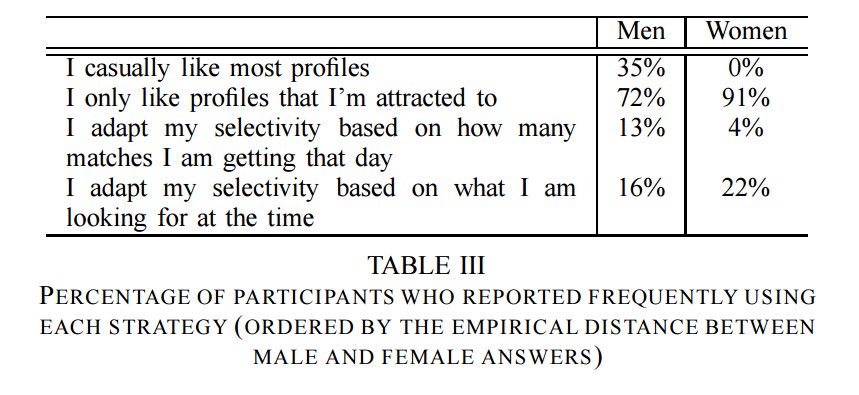
(Ortega & Hergovich, 2017)
Let us make the assumption that this 35% of men is the bottom 35% in terms of looks. While this isn't true at all, we can use this as a foundation to explain why this means that ugly men are fucked.
This means that if you are in the 25th percentile in terms of looks (75% of men are more attractive than you). Then you are still going to be less attractive than 10% of men who swipe right on every woman. Meaning, that on the off chance that there is a truly hideous, undesirable woman who is swiping right on every man, she will still run into a large number of men who have swiped right on her AND are more attractive than you. Obviously, the worse off you are in appearance, the more men there are who are more attractive than you and are swiping right on EVERY woman.
Don't forget the assumption we made earlier - that the 35% of men who swipe right on every woman is also the bottom 35%. The simple fact is that this is not the case. What this means is that even if you are at the 35th or 50th percentile of men by looks, there will still be men more attractive than you who are swiping right on every woman.
This supports the theory of intersexual competition between males, and the intrasexual selection done by females. This also support the sexual accessibility theory.

(Ortega & Hergovich, 2017)
Let us make the assumption that this 35% of men is the bottom 35% in terms of looks. While this isn't true at all, we can use this as a foundation to explain why this means that ugly men are fucked.
This means that if you are in the 25th percentile in terms of looks (75% of men are more attractive than you). Then you are still going to be less attractive than 10% of men who swipe right on every woman. Meaning, that on the off chance that there is a truly hideous, undesirable woman who is swiping right on every man, she will still run into a large number of men who have swiped right on her AND are more attractive than you. Obviously, the worse off you are in appearance, the more men there are who are more attractive than you and are swiping right on EVERY woman.
Don't forget the assumption we made earlier - that the 35% of men who swipe right on every woman is also the bottom 35%. The simple fact is that this is not the case. What this means is that even if you are at the 35th or 50th percentile of men by looks, there will still be men more attractive than you who are swiping right on every woman.
This supports the theory of intersexual competition between males, and the intrasexual selection done by females. This also support the sexual accessibility theory.
4.1b: Even if you get a match, you're probably too late
As the aforementioned theories suggest, men would be eager to jump on any prospect that opens up to them as soon as possible. This is confirmed through the research:
"63% of messages sent by men occur within 5 minutes of the match taking place. This is only 18% for women, suggesting that female users often wait to receive a message first. The median delay for sending messages is just 2 minutes for men, compared to 38 minutes for women. This could be driven by several factors, but it is well known that men often have to compete and differentiate themselves more as part of the mating ritual."
(Ortega & Hergovich, 2017)
Let's say it's a Friday night at 9 PM. Hormones are heavy in the air on the streets of your local downtown area, and it is the prime time for match-making on services like Tinder.
By some miracle, you as an ugly man have matched with a woman. However, because we know that so many men, some of which are more attractive than you, are right swiping everyone, chances are you're not the first to have matched with this woman. It's okay, there is still hope! If you send a message quickly, she will surely take notice of you, right?
Wrong. Your strategy is the same for the vast majority of men.
Every time you see a statistic attached to men, try the thought experiment we ran in 4.1a. Imagine that instead of it being just 63% of messages sent by men, but the messages sent by the bottom 63% of men. Even then, a 25th percentile man will be mogged by men up to 38 percentile points above him.
Now, what if by some stroke of luck, you're not too late? We're in the clear, right?
Wrong again. As we read above, women are consistently looking to upgrade their potential mate. As a result, if a more attractive man matches and messages the woman while she is conversing you, what's stopping her from ghosting you and talking to him instead? Nothing at all.
This is just a hypothetical situation without any data, so let's migrate back to more data-rich pastures in the next few sections.
"63% of messages sent by men occur within 5 minutes of the match taking place. This is only 18% for women, suggesting that female users often wait to receive a message first. The median delay for sending messages is just 2 minutes for men, compared to 38 minutes for women. This could be driven by several factors, but it is well known that men often have to compete and differentiate themselves more as part of the mating ritual."
(Ortega & Hergovich, 2017)
Let's say it's a Friday night at 9 PM. Hormones are heavy in the air on the streets of your local downtown area, and it is the prime time for match-making on services like Tinder.
By some miracle, you as an ugly man have matched with a woman. However, because we know that so many men, some of which are more attractive than you, are right swiping everyone, chances are you're not the first to have matched with this woman. It's okay, there is still hope! If you send a message quickly, she will surely take notice of you, right?
Wrong. Your strategy is the same for the vast majority of men.
Every time you see a statistic attached to men, try the thought experiment we ran in 4.1a. Imagine that instead of it being just 63% of messages sent by men, but the messages sent by the bottom 63% of men. Even then, a 25th percentile man will be mogged by men up to 38 percentile points above him.
Now, what if by some stroke of luck, you're not too late? We're in the clear, right?
Wrong again. As we read above, women are consistently looking to upgrade their potential mate. As a result, if a more attractive man matches and messages the woman while she is conversing you, what's stopping her from ghosting you and talking to him instead? Nothing at all.
This is just a hypothetical situation without any data, so let's migrate back to more data-rich pastures in the next few sections.
4.1c: Women are the ones with unrealistic beauty standards
To preface this point, we need to keep in mind what are the mathematically proven standards for being attractive, "medium," and "significantly below medium" according to the opposite sex:
Attractive

"Medium"

"Significantly below medium"

(Rudder, 2009 November)
Note: the staff at OkCupid didn't think it acceptable to present you with real profiles of men and women who were rated "significantly below medium." However, they were comfortable with sharing their own profiles, which were also rated "significantly below medium." In other words, the staff of OkCupid consists in part of unattractive men. I don't want to jump to any unsubstantiated conclusions, but it does seem to be a very interesting phenomenon.
It's bad enough that as an unattractive male you are objectively mogged by your competitors who are swiping right on everyone. Women also espouse standards of beauty that aren't just vaguely unrealistic, they are mathematically impossible.

"The two curves together suggest some strange possibilities for the female thought process, the most salient of which is that the average-looking woman has convinced herself that the vast majority of males aren’t good enough for her, but she then goes right out and messages them anyway.”
(Rudder, 2009 November)
This graph demonstrates that women place the top 80% of men as being below-average in looks. In other words, while you may objectively be at the 25th percentile in terms of looks, women will consistently underrate your appearance. Put even more simply, to a woman you are even uglier than you actually are.
“It’s women, not men, who have unrealistic standards for the “average” member of the opposite sex.”
(Rudder, 2009 November)
The second part of the quote by Rudder really drives home the asymmetry in the current dating market in terms of partner attitudes: women message men who she thinks are less attractive than her consistently, so is immediately approaching the situation as a disappointment or a step down from what she thinks she deserves.
This demonstrates that women are selective to the point of mathematical impossibility.
It is also worth noting the stark contrast between the female and male attractiveness rating distribution:
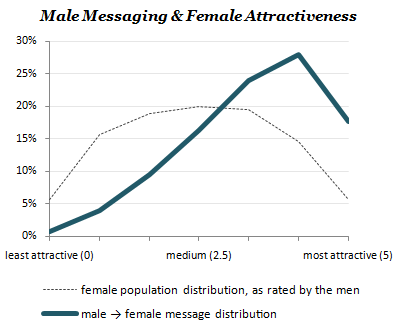
(Rudder, 2009 November)
As can be seen in the above graph, male assessment of female beauty in the market depicts a largely normal curve. implying an incredibly realistic and sensible rating scale. Simply put, 50% of women are above average, 50% of women are below average, and either extreme is much less represented than the middle (~average).
Their messaging habits are also highly sensible, in that "2/3 of male messages go to the top 1/3 of women," as is stated in the article cited above. The majority of men are seeking to copulate with the most attractive available women in their area.
"A hot woman receives 4x the messages an average-looking woman gets, and 25x as many as an ugly one."
(Rudder, 2011)
Let's run our thought experiment one more time. What this means for unattractive men who are also naturally inclined to find the top 1/3 of women attractive is that even if those 2/3 of men were all "reachers" in the sense that they are the bottom 66% in terms of looks, and are all looking to hook up with the top 33% of women in terms of looks, for the average 25th percentile man messaging a woman in the top 1/3, he is competing against men that are up to 40 percentile points more attractive than him.
Keep in mind, again, that this hypothetical situation is veritably false, and that the man at the 25th percentile is habitually getting mogged by men who are MORE than 40 percentile points more attractive than him whenever he messages a woman who is above the 66th percentile in terms of looks.
Attractive

"Medium"

"Significantly below medium"

(Rudder, 2009 November)
Note: the staff at OkCupid didn't think it acceptable to present you with real profiles of men and women who were rated "significantly below medium." However, they were comfortable with sharing their own profiles, which were also rated "significantly below medium." In other words, the staff of OkCupid consists in part of unattractive men. I don't want to jump to any unsubstantiated conclusions, but it does seem to be a very interesting phenomenon.
It's bad enough that as an unattractive male you are objectively mogged by your competitors who are swiping right on everyone. Women also espouse standards of beauty that aren't just vaguely unrealistic, they are mathematically impossible.

"The two curves together suggest some strange possibilities for the female thought process, the most salient of which is that the average-looking woman has convinced herself that the vast majority of males aren’t good enough for her, but she then goes right out and messages them anyway.”
(Rudder, 2009 November)
This graph demonstrates that women place the top 80% of men as being below-average in looks. In other words, while you may objectively be at the 25th percentile in terms of looks, women will consistently underrate your appearance. Put even more simply, to a woman you are even uglier than you actually are.
“It’s women, not men, who have unrealistic standards for the “average” member of the opposite sex.”
(Rudder, 2009 November)
The second part of the quote by Rudder really drives home the asymmetry in the current dating market in terms of partner attitudes: women message men who she thinks are less attractive than her consistently, so is immediately approaching the situation as a disappointment or a step down from what she thinks she deserves.
This demonstrates that women are selective to the point of mathematical impossibility.
It is also worth noting the stark contrast between the female and male attractiveness rating distribution:

(Rudder, 2009 November)
As can be seen in the above graph, male assessment of female beauty in the market depicts a largely normal curve. implying an incredibly realistic and sensible rating scale. Simply put, 50% of women are above average, 50% of women are below average, and either extreme is much less represented than the middle (~average).
Their messaging habits are also highly sensible, in that "2/3 of male messages go to the top 1/3 of women," as is stated in the article cited above. The majority of men are seeking to copulate with the most attractive available women in their area.
"A hot woman receives 4x the messages an average-looking woman gets, and 25x as many as an ugly one."
(Rudder, 2011)
Let's run our thought experiment one more time. What this means for unattractive men who are also naturally inclined to find the top 1/3 of women attractive is that even if those 2/3 of men were all "reachers" in the sense that they are the bottom 66% in terms of looks, and are all looking to hook up with the top 33% of women in terms of looks, for the average 25th percentile man messaging a woman in the top 1/3, he is competing against men that are up to 40 percentile points more attractive than him.
Keep in mind, again, that this hypothetical situation is veritably false, and that the man at the 25th percentile is habitually getting mogged by men who are MORE than 40 percentile points more attractive than him whenever he messages a woman who is above the 66th percentile in terms of looks.
4.1d: Everyone, on average, is "reaching up"
"When we looked specifically at sending the first message, we found one striking habit: everyone’s a reacher, meaning people tend to reach out to someone more attractive than they are. To put a number on it, men are reaching out to women 17 percentile points more attractive, and women contact men who are 10 percentile points more attractive. This means that if a woman does nothing, her inbox will be filled with less attractive men.“
(Cooper, 2015)
OkCupid and other dating services have an internal algorithm that measures a person's attractiveness; this is computed by an Elo-like system. While this is unfortunate for ugly men with high standards to begin with, it also means we can quantifiably explain why unattractive men get limited attention on the service.
We already know that 2/3rds of men message the top 1/3 of women, there it's not surprising that men are reaching out to women who are on average 17 percentile points more attractive. It's also perhaps unsurprising that women reach out to men who are 10 percentile points above them as well; after all, everyone wants to secure the best possible mate for themselves, and everyone is attracted to attractive people. However, keep in mind that this is an average of all women's messaging. Why is this important?
Well, for one thing, women who are at the 91st and above percentile physically CAN'T message men who are 10 points above them. That means that on average, the women who are at the 90th and above percentile must consistently bring down the average difference between a female sender and male recipient. The difference is therefore likely made up elsewhere - for example, women who are less attractive messaging men who are 30 or 40 points above them.
This explains why, as our hypothetical 25th percentile male, you may look at the quote above and think "Oh! That means that at the very least, I'll get messages from women who are in the 15th percentile!" Unfortunately that is not what this number means to you; those women are still likely to be looking for more attractive males than you (just as 2/3rds of men message the top 1/3rd of females).
Add on top of this the fact that as we learned in 4.1c, women have objectively faulty standards for beauty. This creates the following paradox: Women consistently message men they deem to be below themselves, yet consistently message men who are above themselves in terms of attractiveness. This means that when a woman is messaging a guy who is more attractive than her, she thinks she is downgrading. Meanwhile, as mentioned above, your messages to her rot in her inbox. If the average woman thinks that the average man men that is 10 points above her is beneath her standards, and she is on average 17 points more attactive than you if you sent that first message, then how do you think she feels about YOU? If you are our 25th percentile subject, that means that typically speaking, she is at the 42nd percentile (slightly below average, not exactly a steal), and the guy that she thinks is beneath her standards is in the 52nd percentile. Read that again - the guy who is decidedly average, and mathematically speaking twice as attractive, is viewed as a downgrade by your REACH option. There's only so many ways I can rephrase this and present it in different ways, so let me just get to the conclusion: it's over.
As I mentioned before, the 10 percentile points is an average and the 25th percentile subject is hypothetical. However, what do the real numbers say about the potential success rate of these people who are reaching for more attractive partners?

(Rudder, 2009 November)
While this is probably extremely intuitive for the members of this site, it needs to be said: while it is true that on average men reach for women more attractive than themselves, the success rate of these advances is heavily dependent on not only the man's absolute attractiveness but also his relative attractiveness to his target, as can be seen in the graph above. In other words, the chances for unattractive men to bat outside of their league is much lower than it is for every man who is more attractive than him.
(Cooper, 2015)
OkCupid and other dating services have an internal algorithm that measures a person's attractiveness; this is computed by an Elo-like system. While this is unfortunate for ugly men with high standards to begin with, it also means we can quantifiably explain why unattractive men get limited attention on the service.
We already know that 2/3rds of men message the top 1/3 of women, there it's not surprising that men are reaching out to women who are on average 17 percentile points more attractive. It's also perhaps unsurprising that women reach out to men who are 10 percentile points above them as well; after all, everyone wants to secure the best possible mate for themselves, and everyone is attracted to attractive people. However, keep in mind that this is an average of all women's messaging. Why is this important?
Well, for one thing, women who are at the 91st and above percentile physically CAN'T message men who are 10 points above them. That means that on average, the women who are at the 90th and above percentile must consistently bring down the average difference between a female sender and male recipient. The difference is therefore likely made up elsewhere - for example, women who are less attractive messaging men who are 30 or 40 points above them.
This explains why, as our hypothetical 25th percentile male, you may look at the quote above and think "Oh! That means that at the very least, I'll get messages from women who are in the 15th percentile!" Unfortunately that is not what this number means to you; those women are still likely to be looking for more attractive males than you (just as 2/3rds of men message the top 1/3rd of females).
Add on top of this the fact that as we learned in 4.1c, women have objectively faulty standards for beauty. This creates the following paradox: Women consistently message men they deem to be below themselves, yet consistently message men who are above themselves in terms of attractiveness. This means that when a woman is messaging a guy who is more attractive than her, she thinks she is downgrading. Meanwhile, as mentioned above, your messages to her rot in her inbox. If the average woman thinks that the average man men that is 10 points above her is beneath her standards, and she is on average 17 points more attactive than you if you sent that first message, then how do you think she feels about YOU? If you are our 25th percentile subject, that means that typically speaking, she is at the 42nd percentile (slightly below average, not exactly a steal), and the guy that she thinks is beneath her standards is in the 52nd percentile. Read that again - the guy who is decidedly average, and mathematically speaking twice as attractive, is viewed as a downgrade by your REACH option. There's only so many ways I can rephrase this and present it in different ways, so let me just get to the conclusion: it's over.
As I mentioned before, the 10 percentile points is an average and the 25th percentile subject is hypothetical. However, what do the real numbers say about the potential success rate of these people who are reaching for more attractive partners?

(Rudder, 2009 November)
While this is probably extremely intuitive for the members of this site, it needs to be said: while it is true that on average men reach for women more attractive than themselves, the success rate of these advances is heavily dependent on not only the man's absolute attractiveness but also his relative attractiveness to his target, as can be seen in the graph above. In other words, the chances for unattractive men to bat outside of their league is much lower than it is for every man who is more attractive than him.
The next few subtopics will focus on particular flaws that men have that affect their dating (and mating) chances in the modern era. They will not be as lengthy as the first, as being generally considered unattractive encompasses these elements to varying degrees in every individual, and they are also potentially harder to control for.
One of the reasons why it's hard to control for things like height, for example, is because users on OkCupid and Tinder lie about their height, a lot.

(Rudder, 2010)
Based on a data set of 1.51 million users, Christian Rudder of OkCupid was able to demonstrate that either OkCupid male users are taller, or they are lying. Furthermore, "this means that... as they get closer to six feet [they] round up a bit more than usual, stretching for that coveted psychological benchmark," (2010).
Women are guilty of this too, but due to the nature of selectivity that we have discussed at length, I find it unsurprising that it is much easier to find examples of women taunting short men than it is to find the same interaction with the sexes switched. While the users on this board should be well aware of the many examples, I've included a few here just for posterity and in case someone not in the know is perusing this:
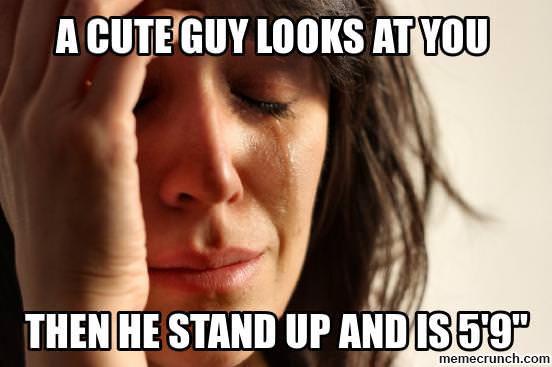
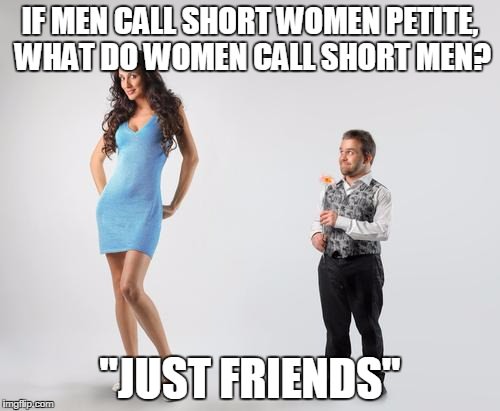
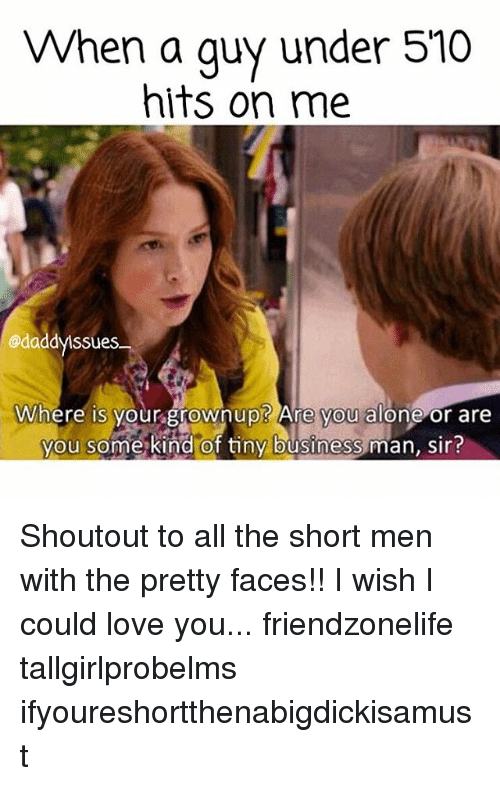
What some may write off as jokes, memes, or Twitter trolling, has a very real and observable effect on the dating market.
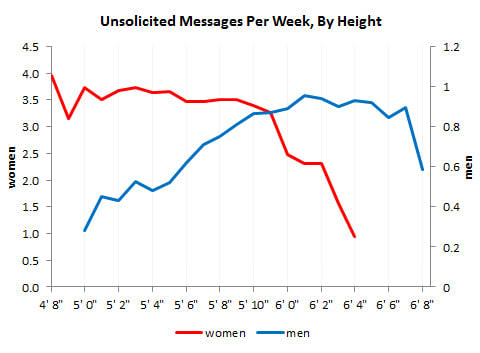
(Rudder, 2010)
Women consistently message men who are taller, with the trend peaking at just past 6'0'' and continuing until a dip at 6'8''. Clearly, height has an influence on the likelihood of getting initial interest from women. That's not all, however.
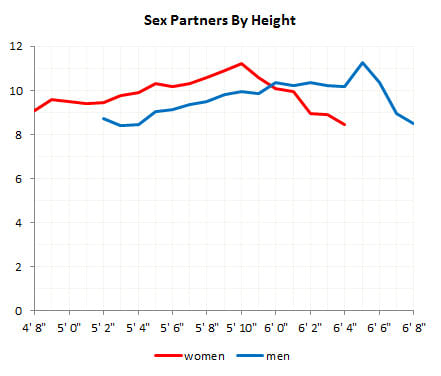
(Rudder, 2010)
While this data is clearly self-report, it is worth noting that even given the likely number inflation by certain dating site users, taller men end up with a greater number of sexual partners. Given the factual data about messages received by men vs. their height, we have three possible explanations for these numbers:
1. Taller men lie more about their sexual escapades, while also receiving a greater amount of positive female attention.
2. Shorter men lie more about their sexual escapades, while also receiving a lesser amount of positive female attention.
I think that it is clear which explanation is more logically consistent.
One of the reasons why it's hard to control for things like height, for example, is because users on OkCupid and Tinder lie about their height, a lot.

(Rudder, 2010)
Based on a data set of 1.51 million users, Christian Rudder of OkCupid was able to demonstrate that either OkCupid male users are taller, or they are lying. Furthermore, "this means that... as they get closer to six feet [they] round up a bit more than usual, stretching for that coveted psychological benchmark," (2010).
Women are guilty of this too, but due to the nature of selectivity that we have discussed at length, I find it unsurprising that it is much easier to find examples of women taunting short men than it is to find the same interaction with the sexes switched. While the users on this board should be well aware of the many examples, I've included a few here just for posterity and in case someone not in the know is perusing this:



What some may write off as jokes, memes, or Twitter trolling, has a very real and observable effect on the dating market.

(Rudder, 2010)
Women consistently message men who are taller, with the trend peaking at just past 6'0'' and continuing until a dip at 6'8''. Clearly, height has an influence on the likelihood of getting initial interest from women. That's not all, however.

(Rudder, 2010)
While this data is clearly self-report, it is worth noting that even given the likely number inflation by certain dating site users, taller men end up with a greater number of sexual partners. Given the factual data about messages received by men vs. their height, we have three possible explanations for these numbers:
1. Taller men lie more about their sexual escapades, while also receiving a greater amount of positive female attention.
2. Shorter men lie more about their sexual escapades, while also receiving a lesser amount of positive female attention.
I think that it is clear which explanation is more logically consistent.
There is a well-known sociological phenomenon known as "in-group out-group bias." Basically any unifying characteristic between multiple individuals can form the foundation of an "in-group," such as incels on incels.is. People who do not possess those characteristics or possess opposing characteristics are seen as the "out-group." We are naturally inclined to find camaraderie with and act favorably towards those in our in-group, while acting with suspicion, derision, or animosity towards the out-group. This is so well-documented that I struggle to find a legitimate source, such as a textbook, that is readily available that has a basic overview of the subject, but here is the Wikipedia page for the phenomenon for your perusal:
https://en.wikipedia.org/wiki/Ingroups_and_outgroups
Here is an article using the bias as a foundation for an argument about insularity breeding extremism (something that incel communities are accused of, as many of you well know):
https://www.psychologytoday.com/us/...n-groups-out-groups-and-the-psychology-crowds
"In-group" and "out-group" can be succinctly phrased as "us" and "them." As Pink Floyd poetically said in the aptly-named "Us and Them":
Us, and them,
And after all, we're only ordinary men
Unfortunately, research in the fields of evolutionary psychology and sociology has demonstrated time and time again that we are not ALL simply ordinary men. Just as equality is a virtue that is praised but remains untenable due to the inherent inequalities of nature and the world at large, being "ordinary men" is a fate that not everyone shares. To further complicate matters, "ordinary" heavily depends on context; depending on where you are, certain qualities, characteristics, and behaviors are either acceptable or unacceptable, normal or abnormal. Standards for beauty, and thus potential for attraction, are no different.
As such, dating services in the West have produced enormous amounts of data supporting the in-group out-group bias, in the form of match statistics based on race x gender. Unsurprisingly, ethnic men on average struggle greatly in comparison with their Caucasian compatriots.
Some initial work done by Christian Rudder from OkCupid demonstrated that there are "unexpected" differences in response rates in reciprocal situations (when a white man messages a black woman vs. when a black woman messages a white man, for example):
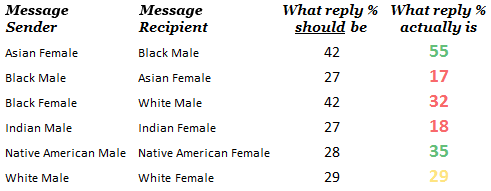
(Rudder, 2009 October)
I believe the statistics here are relatively self-explanatory.
Using this as a justification for further research, Rudder has provided us with the following charts:
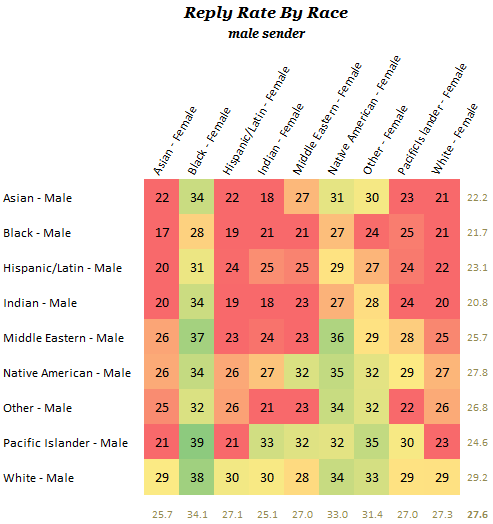
(Rudder, 2009 October)
What you see above are the response rates when a man of a certain race messages a woman of a certain race.
Some interesting things to note:
1. White men get more responses when matched with almost any race of woman than any other race, in some cases more than men who are of the same race as the women.
2. Everyone else does relatively poorly with everyone, with the exception of Pacific Islanders doing surprisingly well with some females.
3. Asian men are the only group of people to do as poorly as Indian men do with Indian women.
4. The only pairing that is even less fortuitous for the man (than Indian x Indian or Asian x Indian) is when he is black and the woman is Asian.
The major point here is this: that white men are almost always more likely to receive a response than their ethnic counterparts, regardless of the race of the recipient.
One thing that I excluded from the above list of interesting things to note is that black females seem to be the most receptive of all females. I left it out because of this chart:

(Rudder, 2009 October)
It is unlikely to be a coincidence that black females, the racial representatives most likely to respond to male messages, are the ones who are getting responded to the least. Meanwhile, white men, who receive the most responses from their targets, are also the ones that respond the least to others. It is clear that ethnic men struggle in a similar fashion to black women, as they don't have the luxury of being as selective as white men because they get less attention and fewer responses in the first place.
In 2014, when reviewing how the data has changed in the 5 years since the first series of analyses was run, he found that in the same time window in which Obama had been re-elected for a second term and progressive social movements were gaining traction, the changes to the race x gender dynamics of the sexual landscape had barely changed at all.
(Rudder, 2014, September 10)
This is hardly surprising given what we know about evolutionary psychology - that we are evolving much slower than the world around us. An apt analogy for this was put forward by Cosmides and Tooby, who have stated that in our "modern skulls" resides a "stone-age brain," (1997, p. 90). Just as the other criteria for desirable mates have remained largely unchanged throughout the millennia, the in-group out-group bias that kept our ancestors from killing their clanmates over a minor crime and prevented them from approaching militant enemy tribes trustingly and unarmed, remains alive an well in our selection of partner based on race.
https://en.wikipedia.org/wiki/Ingroups_and_outgroups
Here is an article using the bias as a foundation for an argument about insularity breeding extremism (something that incel communities are accused of, as many of you well know):
https://www.psychologytoday.com/us/...n-groups-out-groups-and-the-psychology-crowds
"In-group" and "out-group" can be succinctly phrased as "us" and "them." As Pink Floyd poetically said in the aptly-named "Us and Them":
Us, and them,
And after all, we're only ordinary men
Unfortunately, research in the fields of evolutionary psychology and sociology has demonstrated time and time again that we are not ALL simply ordinary men. Just as equality is a virtue that is praised but remains untenable due to the inherent inequalities of nature and the world at large, being "ordinary men" is a fate that not everyone shares. To further complicate matters, "ordinary" heavily depends on context; depending on where you are, certain qualities, characteristics, and behaviors are either acceptable or unacceptable, normal or abnormal. Standards for beauty, and thus potential for attraction, are no different.
As such, dating services in the West have produced enormous amounts of data supporting the in-group out-group bias, in the form of match statistics based on race x gender. Unsurprisingly, ethnic men on average struggle greatly in comparison with their Caucasian compatriots.
Some initial work done by Christian Rudder from OkCupid demonstrated that there are "unexpected" differences in response rates in reciprocal situations (when a white man messages a black woman vs. when a black woman messages a white man, for example):

(Rudder, 2009 October)
I believe the statistics here are relatively self-explanatory.
Using this as a justification for further research, Rudder has provided us with the following charts:

(Rudder, 2009 October)
What you see above are the response rates when a man of a certain race messages a woman of a certain race.
Some interesting things to note:
1. White men get more responses when matched with almost any race of woman than any other race, in some cases more than men who are of the same race as the women.
2. Everyone else does relatively poorly with everyone, with the exception of Pacific Islanders doing surprisingly well with some females.
3. Asian men are the only group of people to do as poorly as Indian men do with Indian women.
4. The only pairing that is even less fortuitous for the man (than Indian x Indian or Asian x Indian) is when he is black and the woman is Asian.
The major point here is this: that white men are almost always more likely to receive a response than their ethnic counterparts, regardless of the race of the recipient.
One thing that I excluded from the above list of interesting things to note is that black females seem to be the most receptive of all females. I left it out because of this chart:

(Rudder, 2009 October)
It is unlikely to be a coincidence that black females, the racial representatives most likely to respond to male messages, are the ones who are getting responded to the least. Meanwhile, white men, who receive the most responses from their targets, are also the ones that respond the least to others. It is clear that ethnic men struggle in a similar fashion to black women, as they don't have the luxury of being as selective as white men because they get less attention and fewer responses in the first place.
In 2014, when reviewing how the data has changed in the 5 years since the first series of analyses was run, he found that in the same time window in which Obama had been re-elected for a second term and progressive social movements were gaining traction, the changes to the race x gender dynamics of the sexual landscape had barely changed at all.
(Rudder, 2014, September 10)
This is hardly surprising given what we know about evolutionary psychology - that we are evolving much slower than the world around us. An apt analogy for this was put forward by Cosmides and Tooby, who have stated that in our "modern skulls" resides a "stone-age brain," (1997, p. 90). Just as the other criteria for desirable mates have remained largely unchanged throughout the millennia, the in-group out-group bias that kept our ancestors from killing their clanmates over a minor crime and prevented them from approaching militant enemy tribes trustingly and unarmed, remains alive an well in our selection of partner based on race.
As we learned in the first few sections of this post, women have been seeking males who can satisfy a providing role in their lives for at least 2 million years. The inventions of farming and barter, coinage, and the wage economy have happened, relatively speaking, so recently that it is astonishing that women in the West have already adapted their preferences to some degree from desiring a man who can hunt to a man who earns money. Perhaps this speaks to the universal and malleable nature of the provider role, and how it is not any absolute value or quality that satisfies it, but a value that is contextually important. While this is an interesting topic that could explain things like Thailand trips for ex-pats, this isn't the focus of this sub-topic. It's how poor men in the West fill the same role as a crippled man would have 2 million years ago, when his value and ability to provide was measured by his ability to hunt and protect his family.
The first indicator we have that wealth and income are objectively important metrics is that, much like height, an overwhelming amount of people lie about their income.
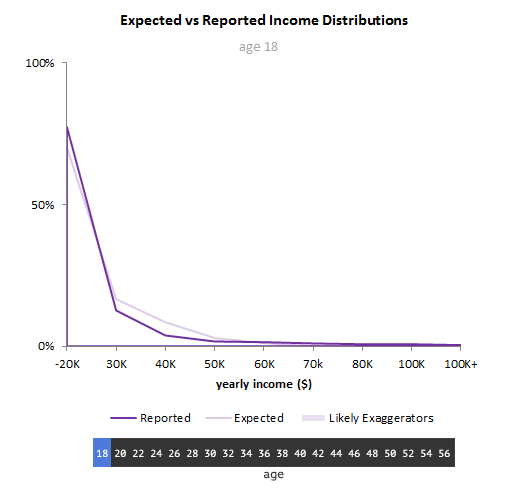
"Look at the graph to watch as people exaggerate more as they get older. As you can see, people advertise disproportionately high salaries for themselves. Just to pick a symbolic amount, there are consistently 4× the number of people making $100K a year than there should be."
(Rudder, 2010)
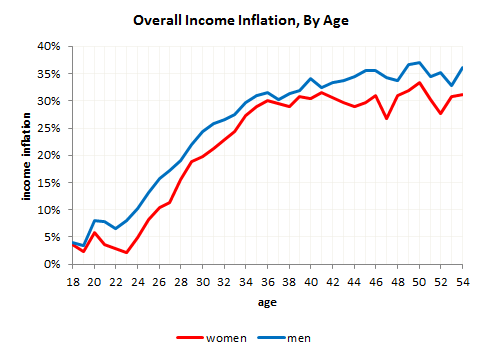
"For each age we were very careful to adjust for OkCupid’s particular demographics: we compared every individual against the average not just by age but by zip code."
(Rudder, 2010)
As can be seen in the above graph, men consistently exaggerate more than women do. Again, given what we know from the earlier sections, this is not unexpected.
However, does all this posturing and lying pay off? Does it serve a purpose besides covering for some insecurities?

(Rudder, 2010)
For men, you bet your ass it does. Christian Rudder drops a massive blackpill in this OkCupid article; so perfectly worded, I don't need to emphasize or rephrase anything:
"If you’re a young guy and don’t make much money, cool. If you’re 23 or older and don’t make much money, go die in a fire."
What makes this phenomenon even worse is that it is habitually perpetuated by men themselves. As each individual man, in his own self-interest of maximizing his chances of copulating, lies about his income, projects an image of wealth that may not be representative of his true earnings, and strives to fit the provider role ideal, he over-inflates the expectations of women and the disparity between appearance and reality. In other words, while women are deceived into thinking that there are four times as many six-figure-salary men in the dating pool as there really are, she naturally thinks her chances of securing one are four times higher than they truly are, at any level of attractiveness. When her girlfriend hooks up with one of these men, there is a 75% chance that he was lying about his income to begin with, but how would she know that if she doesn't look at his bank statement? He will continue to accrue items that display the wealth he does not have, and spend lavishly in ways he cannot afford, until he either finally makes it to his promised income level or crumbles. Until that happens, our original woman, seeing her friend securing a man who on the surface seems to fit the provider role perfectly with his claimed six-figure-salary, will hold out until she can meet a man in a similar position, not knowing the whole time that she has a 75% chance of being bamboozled.
For poor men, they can't even pretend to run the fake wealth game, because if they do not have, do not buy, and do not do the things that richer men have, they will be much less likely to be believed. Not only do we have the data-driven evidence above of how a woman is unlikely to consider a poor man, we have anecdotal evidence of how a woman is unlikely to stay with a man that she claims to love if she perceives him as being poor as well:
Orginal TwoXChromosomes post, conveniently deleted by mods. One user asks "What happened here?" Another aptly responds, "Just moderator in damage control mode. Sometimes, even special snowflakes melt." As you will soon see, this is unsurprising given that this post unintentionally revealed the dark underbelly of the female provider-seeking nature, and the female mods felt threatened by such a revelation.
Thankfully, the "Pussy Pass Denied" sub took notice of this post and preserved it for our reading pleasure. You can also find the full text below:
"If a man with disposable income meets a woman he likes, doesn't he want to treat her? He said he "saw me in his future", why didn't he care enough to share these things with me?"
(into-the-abyss, 2015)
This again can be attributed to not only the evolutionary foundation of such thought processes and behaviors, but to the firm perpetuation of such standards by men on average. A study conducted in 2017 showed that while only a slight majority of women (56%) preferred for the man to pay the bill on a first date, a full 86% of men said that they preferred to do so (Murray). What this means is that the male self-professed desire to fit the provider role outpaces the female self-professed admission that fitting the provider role is necessary. In other words, men are actively inflating the standards of women by shoehorning themselves into the provider role at a greater rate than is potentially expected of them. Meanwhile, poor men are unable to compete with this standard.
If anyone wonders what is driving the "hood rich" phenomenon of driving a Beamer, Benz, or Bentley while their baby mama is still on food stamps, look no further.
The first indicator we have that wealth and income are objectively important metrics is that, much like height, an overwhelming amount of people lie about their income.

"Look at the graph to watch as people exaggerate more as they get older. As you can see, people advertise disproportionately high salaries for themselves. Just to pick a symbolic amount, there are consistently 4× the number of people making $100K a year than there should be."
(Rudder, 2010)

"For each age we were very careful to adjust for OkCupid’s particular demographics: we compared every individual against the average not just by age but by zip code."
(Rudder, 2010)
As can be seen in the above graph, men consistently exaggerate more than women do. Again, given what we know from the earlier sections, this is not unexpected.
However, does all this posturing and lying pay off? Does it serve a purpose besides covering for some insecurities?

(Rudder, 2010)
For men, you bet your ass it does. Christian Rudder drops a massive blackpill in this OkCupid article; so perfectly worded, I don't need to emphasize or rephrase anything:
"If you’re a young guy and don’t make much money, cool. If you’re 23 or older and don’t make much money, go die in a fire."
What makes this phenomenon even worse is that it is habitually perpetuated by men themselves. As each individual man, in his own self-interest of maximizing his chances of copulating, lies about his income, projects an image of wealth that may not be representative of his true earnings, and strives to fit the provider role ideal, he over-inflates the expectations of women and the disparity between appearance and reality. In other words, while women are deceived into thinking that there are four times as many six-figure-salary men in the dating pool as there really are, she naturally thinks her chances of securing one are four times higher than they truly are, at any level of attractiveness. When her girlfriend hooks up with one of these men, there is a 75% chance that he was lying about his income to begin with, but how would she know that if she doesn't look at his bank statement? He will continue to accrue items that display the wealth he does not have, and spend lavishly in ways he cannot afford, until he either finally makes it to his promised income level or crumbles. Until that happens, our original woman, seeing her friend securing a man who on the surface seems to fit the provider role perfectly with his claimed six-figure-salary, will hold out until she can meet a man in a similar position, not knowing the whole time that she has a 75% chance of being bamboozled.
For poor men, they can't even pretend to run the fake wealth game, because if they do not have, do not buy, and do not do the things that richer men have, they will be much less likely to be believed. Not only do we have the data-driven evidence above of how a woman is unlikely to consider a poor man, we have anecdotal evidence of how a woman is unlikely to stay with a man that she claims to love if she perceives him as being poor as well:
Orginal TwoXChromosomes post, conveniently deleted by mods. One user asks "What happened here?" Another aptly responds, "Just moderator in damage control mode. Sometimes, even special snowflakes melt." As you will soon see, this is unsurprising given that this post unintentionally revealed the dark underbelly of the female provider-seeking nature, and the female mods felt threatened by such a revelation.
Thankfully, the "Pussy Pass Denied" sub took notice of this post and preserved it for our reading pleasure. You can also find the full text below:
Someone PLEASE help make sense of my ex-boyfriends actions. (self.TwoXChromosomes) submitted 7 hours ago by into-the-abyss TL;DR - My boyfriend kept his wealth a secret from me throughout our entire relationship. I ended the relationship on the pretext that he wasn't money/career motivated, he didn't say anything to the contrary.
I [F26] have been dating Will [M27] for most of 2014; I met him on New Years Eve, we exchanged numbers, scheduled a coffee date and have been seeing each other ever since. He's tall and shy, with long thick hair like Eddie Vedder. He lives in an older house by himself and drives a 1997 Toyota. He dresses very casually - I don't think he even owns a collared shirt - and all his clothes are minimum 1-2 years old. For income, he told me he "ran a few websites" and picked up piece-work as a 'session guitarist'. He is also very frugal. He never took me out for fancy dinners or anything. In the beginning it was always coffee dates, walks, hikes, etc. If we go out, he insists on 'pre-drinking' and refuses to buy drinks at a bar. Most nights he was content staying in, watching Netflix and playing his guitar.
I never outright asked how much money he made, but given his lifestyle, clothes, furnishings, etc. plus the fact that he rarely worked, I assumed it wasn't much. I would lightly prod him with questions about the future, if he had any career goals - he would say that he "saw me in his future", but also he was "happy the way things were". I have Facebook and am on it every day, usually when work is slow. Lately my newsfeed has been filled with my peers getting married, buying houses, having babies, and other various accolades. I can't help but feel jealous by this; it seems like everyone but me is making significant gains in their lives and relationships. Three weeks ago, after seeing a girl I knew from high school buy her 3rd property with her husband, it felt like my relationship with Will was juvenile and had no future.
The next time I was over at Will's (after he served me potato soup for dinner and was torrenting a documentary for us to watch later) I ended the relationship. I was perfectly honest about everything - he was a great guy, I loved him and his personality, but I felt he lacked career/life ambition and we wanted different things for the future. He sat and listened to everything, seemingly unmoved by it. When I finished talking, he said "fine by me" and asked me to leave. I went to hug him on my way out, instead he just guided me out the door and slammed it shut behind him. With prior boyfriends, we'd still talk or text a bit after we'd be broken up. Sometimes we'd even still hook up. I dunno, I've just never had a 'bad break-up' and always try to remain on good terms. I haven't heard a fucking word from Will, even after texting him multiple times and calling him once. I saw two of Wills friends at the gym today. I went over and made small talk, asked how he was, etc. I tried to explain myself, saying he was a great guy but our views on money and the future didn't seem to mesh. To this, one friend chuckled to himself and walked away. I asked the other friend WTF that's about it, and he says "Yeah, we heard. The thing is, Will's loaded. He inherited his grandpas land which is leased to oil and gas companies. I've seen the quarterly checks he gets and they're more than my yearly salary. Good luck getting him to spend it, though. He has a 'if it aint broke, dont fix it' type mentality. Just look at that piece of shit he drives!" This has completely baffled and upset me. I dated him for 10 months when I thought he was penniless, proof I'm not a fucking gold-digger. I am a 26 year old woman who needs to be pragmatic, I can't just indefinitely date someone with the future being so uncertain. He could've said something, ANYTHING during our break up when I was explaining my doubts about our relationship. Instead he said nothing, and now he refuses to talk to me. It makes absolutely no sense.
I just feel so low right now. If a man with disposable income meets a woman he likes, doesn't he want to treat her? He said he "saw me in his future", why didn't he care enough to share these things with me? He could have easily kept our relationship alive by being forthcoming. Someone please help me make sense of this situation.
I [F26] have been dating Will [M27] for most of 2014; I met him on New Years Eve, we exchanged numbers, scheduled a coffee date and have been seeing each other ever since. He's tall and shy, with long thick hair like Eddie Vedder. He lives in an older house by himself and drives a 1997 Toyota. He dresses very casually - I don't think he even owns a collared shirt - and all his clothes are minimum 1-2 years old. For income, he told me he "ran a few websites" and picked up piece-work as a 'session guitarist'. He is also very frugal. He never took me out for fancy dinners or anything. In the beginning it was always coffee dates, walks, hikes, etc. If we go out, he insists on 'pre-drinking' and refuses to buy drinks at a bar. Most nights he was content staying in, watching Netflix and playing his guitar.
I never outright asked how much money he made, but given his lifestyle, clothes, furnishings, etc. plus the fact that he rarely worked, I assumed it wasn't much. I would lightly prod him with questions about the future, if he had any career goals - he would say that he "saw me in his future", but also he was "happy the way things were". I have Facebook and am on it every day, usually when work is slow. Lately my newsfeed has been filled with my peers getting married, buying houses, having babies, and other various accolades. I can't help but feel jealous by this; it seems like everyone but me is making significant gains in their lives and relationships. Three weeks ago, after seeing a girl I knew from high school buy her 3rd property with her husband, it felt like my relationship with Will was juvenile and had no future.
The next time I was over at Will's (after he served me potato soup for dinner and was torrenting a documentary for us to watch later) I ended the relationship. I was perfectly honest about everything - he was a great guy, I loved him and his personality, but I felt he lacked career/life ambition and we wanted different things for the future. He sat and listened to everything, seemingly unmoved by it. When I finished talking, he said "fine by me" and asked me to leave. I went to hug him on my way out, instead he just guided me out the door and slammed it shut behind him. With prior boyfriends, we'd still talk or text a bit after we'd be broken up. Sometimes we'd even still hook up. I dunno, I've just never had a 'bad break-up' and always try to remain on good terms. I haven't heard a fucking word from Will, even after texting him multiple times and calling him once. I saw two of Wills friends at the gym today. I went over and made small talk, asked how he was, etc. I tried to explain myself, saying he was a great guy but our views on money and the future didn't seem to mesh. To this, one friend chuckled to himself and walked away. I asked the other friend WTF that's about it, and he says "Yeah, we heard. The thing is, Will's loaded. He inherited his grandpas land which is leased to oil and gas companies. I've seen the quarterly checks he gets and they're more than my yearly salary. Good luck getting him to spend it, though. He has a 'if it aint broke, dont fix it' type mentality. Just look at that piece of shit he drives!" This has completely baffled and upset me. I dated him for 10 months when I thought he was penniless, proof I'm not a fucking gold-digger. I am a 26 year old woman who needs to be pragmatic, I can't just indefinitely date someone with the future being so uncertain. He could've said something, ANYTHING during our break up when I was explaining my doubts about our relationship. Instead he said nothing, and now he refuses to talk to me. It makes absolutely no sense.
I just feel so low right now. If a man with disposable income meets a woman he likes, doesn't he want to treat her? He said he "saw me in his future", why didn't he care enough to share these things with me? He could have easily kept our relationship alive by being forthcoming. Someone please help me make sense of this situation.
"If a man with disposable income meets a woman he likes, doesn't he want to treat her? He said he "saw me in his future", why didn't he care enough to share these things with me?"
(into-the-abyss, 2015)
This again can be attributed to not only the evolutionary foundation of such thought processes and behaviors, but to the firm perpetuation of such standards by men on average. A study conducted in 2017 showed that while only a slight majority of women (56%) preferred for the man to pay the bill on a first date, a full 86% of men said that they preferred to do so (Murray). What this means is that the male self-professed desire to fit the provider role outpaces the female self-professed admission that fitting the provider role is necessary. In other words, men are actively inflating the standards of women by shoehorning themselves into the provider role at a greater rate than is potentially expected of them. Meanwhile, poor men are unable to compete with this standard.
If anyone wonders what is driving the "hood rich" phenomenon of driving a Beamer, Benz, or Bentley while their baby mama is still on food stamps, look no further.
This section is a bit harder to discuss in detail, as the definition of "old" changes based on the context. Let's look at the data first, then see why it's over in different but worsening ways for men as they age, as opposed to defining a clear line of what "old" is.
4.5a: The 40 year wall
One of the first and easiest places to draw a line is at 40 years old for a man.
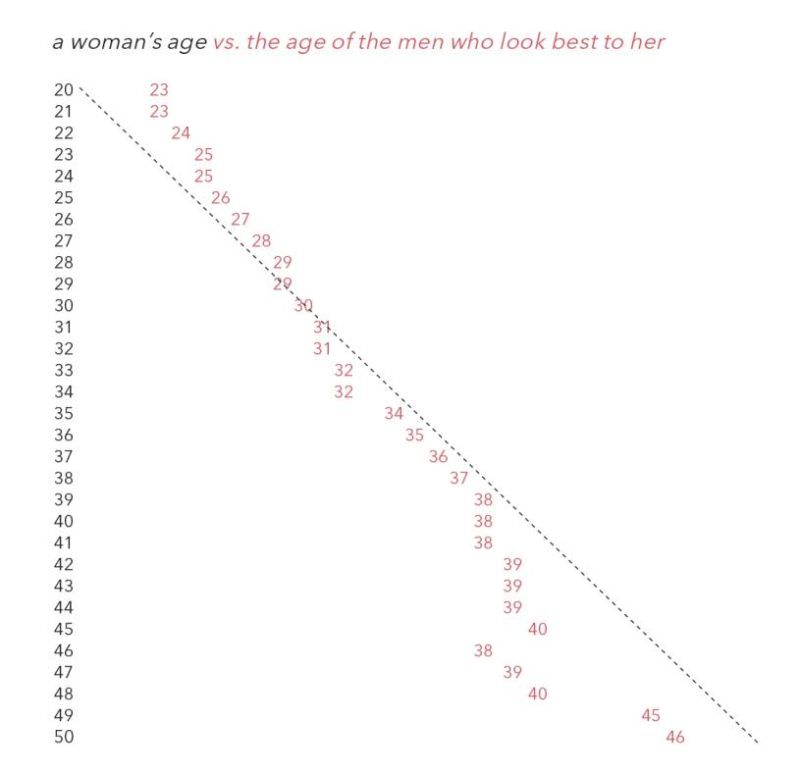
(Rudder, 2015)
What this graph shows plainly is that at 40, a man's appeal has hit a "wall" of sorts. Women from 39 to 48 all prefer men in the 38-40 range (on average), the most significant such block in the data set. However, this sets us up for...
4.5b: The 50 year void
The appeal of older men climbs dramatically as women hit 49 and 50 - but they still prefer men in their mid 40's. Although the data is limited this leaves us begging the question: if 49 and 50 year old women prefer men who are in their mid 40's, who prefers 50 year old men? Until the data is gathered, we can only assume if we follow the trend, it would be women in their mid-50's. By this age, these women are undesirable to just about everyone. 50 year old men, who exist in the void of data and possible attraction, don't find women even close to that age appealing. Here's the male version of the graph we saw above:
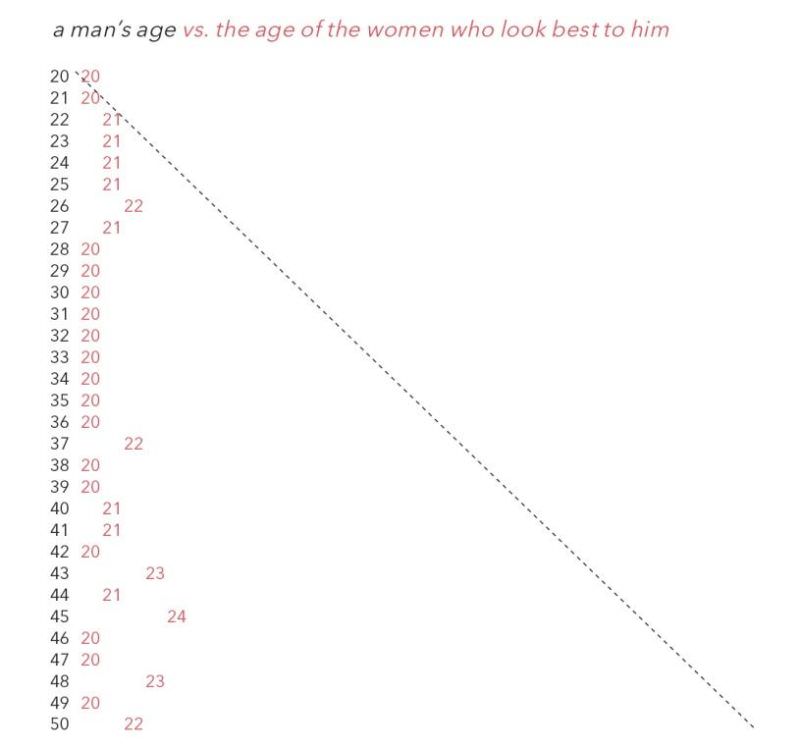
(Rudder, 2015)
What this graph basically means is that 50 year old men are competing with just about every other age group for the same desirable age group of women; if our assumption is correct about women's preferences for 50 year old men, then this paints the following picture for a 50 year old man:
1. He, like all men, are attracted to women in their early 20's; however, he is also the one least likely to succeed with them.
2. He is attractive to women in their mid 50's; however, this is the age group of women that is decades older than the attractive level.
While success rates of 50 year old men with 55 year old women are unknown, the question is, how fortuitous is that success in the first place?
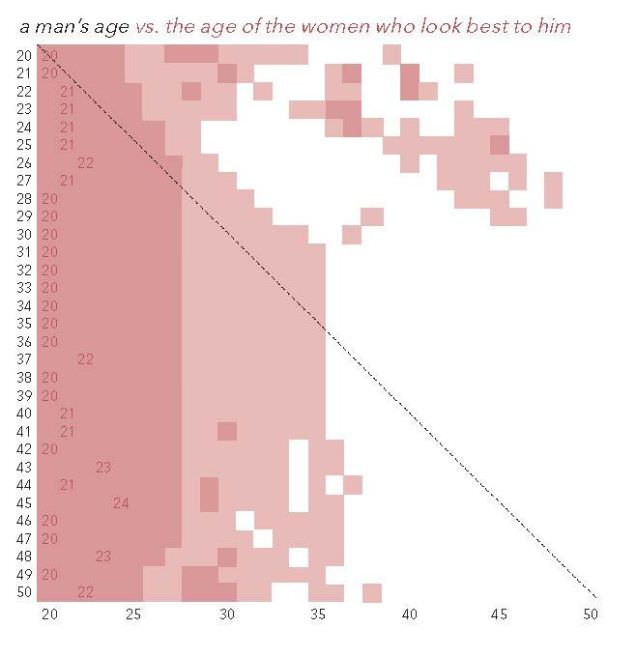
(Rudder, 2015)
In this expanded heatmap of male interest in women by age, we can clearly see that while almost all men are interested in women who are in their early 20s, there is a gradual accommodation for the aging of the male population as well (from 25 to 30, the upper bounds of what a man considers attractive to him increase annually). What is more interesting are the two other trends, and how they spell doom for both 40 and 50 year old men.
Trend 1:
From age 30 to 50, the amount of attraction men feel to women drops off almost entirely when the woman in question is over 35/36 years old.
For old men without standards, this may be a good thing - their female counterparts are now undesirable to an enormous demographic of former competitors. But again we must raise the question, how fortuitous is the potential success of a man at this age with a woman of the same age, if she is considered almost universally undesirable to the rest of men? What have you really "won?"
If we consider the graphs above, we can determine that there are 2 great filters for the female population; after passing each, she is less desirable on average. The first filter is the 20-23 year range, which all men are competing and lusting for. For any woman who manages to get through this period without having been "tied down" to a provider role mate, it is important to question WHY this is the case. Certainly, divorces happen for a multitude of reasons, but some of those reasons are the fault of the woman in question. Some women focus more on their careers and education. Some women are left by "no-good" men. These are all potentially true and valid reasons to be single, but overall, should we be willing to extend the benefit of the doubt to the majority of single women who are above this age and still single? Can we say that the majority of women who are single after the age of 23 are single as a result of purely external forces that are powerful enough to overcome the fact that men of all ages found them to be at peak attractiveness just a year or two ago? Unfortunately, I'm not aware of any data that answers these questions, but I speculate that it is a definite leap of faith to assume that the average woman who is still single after 23 is single because of some external force; I find it more likely to be due to some external selection process. To put it bluntly, I believe that the likelihood of her being disproportionately undesirable in some way is greater than the likelihood of her being single by choice or preference.
The second filter is around the age of 35, as we mentioned before. The heat map clearly demonstrates that women between 23 and 35 are still desirable, albeit to a much lesser degree than their younger counterparts. What this also means is that the last remaining desirable women who did not find a permanent mate by the age of 23 have been mostly paired off by 35. After 35, there are basically no desirable women for men who are ages 30 and above. However, there is one exception, which is the foundation for Trend 2, which we will get to in a moment.
Let's first address the question: as an older man who obtained an older woman because she has less men competing for her, what have you really "won?" The data shows that you have a woman that managed to not be selected, or was selected and then rejected, through two great filters during which the vast majority of male attention was on her. With some obvious exceptions, such as widows and potentially doctors (though many female med students and doctors leave the professions once they find a similarly successful husband), these women are likely to be the equivalent of the fat kid who got picked last in gym class. The one exception, again, is the fact that...
Trend 2:
Men below the age of 30 are disproportionately interested in much older women, i.e. "cougars."
Whether the motivation is oedipal, fetishism, porn-induced, or based on the assumption that their partner wouldn't want to commit (thus opening the doors for "no strings attached" sex), men between the ages of 20 and 30 are all very interested in hunting cougars. This is particularly interesting given that men older than them no longer find them attractive, and why this discrepancy makes it even harder for old men.
Say you are one of those older men who is willing to settle for just about anything - be it a woman who has passed through the two filters and emerged as still single and undesirable to the majority, or a woman who is significantly older than peak attractiveness, or a woman who is older than you. You are now competing with young men who have, for whatever reason, a disproportionate interest in the same women. If posed with the inverse option (woman around your age or an early 20's female), which would you choose?
While it can be argued that because women find men closer to their age more attractive than men who are looking at women close to their age, as can be evidenced in the graph above demonstrating that all men prefer women close to the age of 20, the fact remains that both men and women decrease in desirability over time. This brings us to our next dividing line.
4.5c: The 30 year slope
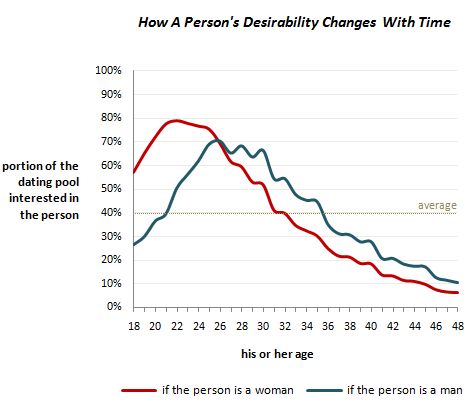
(Rudder, 2010)
As can be clearly seen in the graph above, women reach peak desirability at around 20/21. Before we continue, for the sake of interest, compare the curve of female attraction above to the curve of female fertility below:
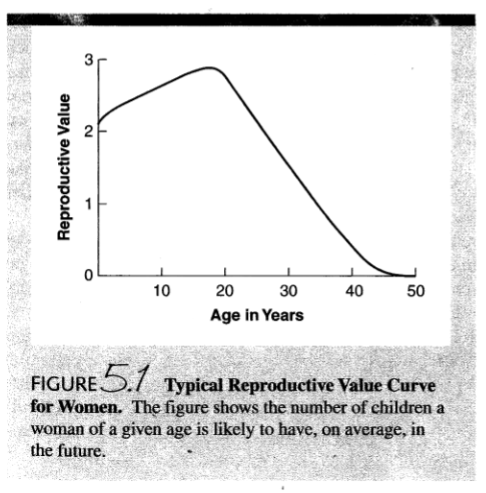
(Buss, 2016)
Moving on to the male curve, we see two clear facts: men peak between 25 and 30, and then fall off precipitously in terms of attractiveness. After age 30, a man will never be as desirable than he was prior to that point (on average). We can see this reflected in the previously listed Rudder graph:

(Rudder, 2015)
While the slope is not as pronounced as it is in the aggregate data, the average "most desirable" age for a man first falls below the age of the female rater precisely at 30, never to rise above it again. This means that after age 30, you will be most attractive to increasingly older and older women, which as we've seen above, are more likely to be closer to the bottom of the barrel as those above them have already been taken ("the good ones are already gone").
While it may not be as over for 30 year olds as it is for 40 or 50 year olds, it will be increasingly more over for them as time goes on.
4.5d: Addendum: struggling as a younger man
If we take a look at the graph measuring desirability vs. age, we see another interesting fact represented therein: men don't peak until 25. What this means is that men who are younger than 25 actually have a lesser chance of success with any woman than men who are between 25 and 30. This was hypothesized earlier when provider roles were discussed, and the data backs it up. However, it is important to note that for young men, it is (on average) most certainly NOT over. It just hasn't begun yet.
4.5a: The 40 year wall
One of the first and easiest places to draw a line is at 40 years old for a man.

(Rudder, 2015)
What this graph shows plainly is that at 40, a man's appeal has hit a "wall" of sorts. Women from 39 to 48 all prefer men in the 38-40 range (on average), the most significant such block in the data set. However, this sets us up for...
4.5b: The 50 year void
The appeal of older men climbs dramatically as women hit 49 and 50 - but they still prefer men in their mid 40's. Although the data is limited this leaves us begging the question: if 49 and 50 year old women prefer men who are in their mid 40's, who prefers 50 year old men? Until the data is gathered, we can only assume if we follow the trend, it would be women in their mid-50's. By this age, these women are undesirable to just about everyone. 50 year old men, who exist in the void of data and possible attraction, don't find women even close to that age appealing. Here's the male version of the graph we saw above:

(Rudder, 2015)
What this graph basically means is that 50 year old men are competing with just about every other age group for the same desirable age group of women; if our assumption is correct about women's preferences for 50 year old men, then this paints the following picture for a 50 year old man:
1. He, like all men, are attracted to women in their early 20's; however, he is also the one least likely to succeed with them.
2. He is attractive to women in their mid 50's; however, this is the age group of women that is decades older than the attractive level.
While success rates of 50 year old men with 55 year old women are unknown, the question is, how fortuitous is that success in the first place?

(Rudder, 2015)
In this expanded heatmap of male interest in women by age, we can clearly see that while almost all men are interested in women who are in their early 20s, there is a gradual accommodation for the aging of the male population as well (from 25 to 30, the upper bounds of what a man considers attractive to him increase annually). What is more interesting are the two other trends, and how they spell doom for both 40 and 50 year old men.
Trend 1:
From age 30 to 50, the amount of attraction men feel to women drops off almost entirely when the woman in question is over 35/36 years old.
For old men without standards, this may be a good thing - their female counterparts are now undesirable to an enormous demographic of former competitors. But again we must raise the question, how fortuitous is the potential success of a man at this age with a woman of the same age, if she is considered almost universally undesirable to the rest of men? What have you really "won?"
If we consider the graphs above, we can determine that there are 2 great filters for the female population; after passing each, she is less desirable on average. The first filter is the 20-23 year range, which all men are competing and lusting for. For any woman who manages to get through this period without having been "tied down" to a provider role mate, it is important to question WHY this is the case. Certainly, divorces happen for a multitude of reasons, but some of those reasons are the fault of the woman in question. Some women focus more on their careers and education. Some women are left by "no-good" men. These are all potentially true and valid reasons to be single, but overall, should we be willing to extend the benefit of the doubt to the majority of single women who are above this age and still single? Can we say that the majority of women who are single after the age of 23 are single as a result of purely external forces that are powerful enough to overcome the fact that men of all ages found them to be at peak attractiveness just a year or two ago? Unfortunately, I'm not aware of any data that answers these questions, but I speculate that it is a definite leap of faith to assume that the average woman who is still single after 23 is single because of some external force; I find it more likely to be due to some external selection process. To put it bluntly, I believe that the likelihood of her being disproportionately undesirable in some way is greater than the likelihood of her being single by choice or preference.
The second filter is around the age of 35, as we mentioned before. The heat map clearly demonstrates that women between 23 and 35 are still desirable, albeit to a much lesser degree than their younger counterparts. What this also means is that the last remaining desirable women who did not find a permanent mate by the age of 23 have been mostly paired off by 35. After 35, there are basically no desirable women for men who are ages 30 and above. However, there is one exception, which is the foundation for Trend 2, which we will get to in a moment.
Let's first address the question: as an older man who obtained an older woman because she has less men competing for her, what have you really "won?" The data shows that you have a woman that managed to not be selected, or was selected and then rejected, through two great filters during which the vast majority of male attention was on her. With some obvious exceptions, such as widows and potentially doctors (though many female med students and doctors leave the professions once they find a similarly successful husband), these women are likely to be the equivalent of the fat kid who got picked last in gym class. The one exception, again, is the fact that...
Trend 2:
Men below the age of 30 are disproportionately interested in much older women, i.e. "cougars."
Whether the motivation is oedipal, fetishism, porn-induced, or based on the assumption that their partner wouldn't want to commit (thus opening the doors for "no strings attached" sex), men between the ages of 20 and 30 are all very interested in hunting cougars. This is particularly interesting given that men older than them no longer find them attractive, and why this discrepancy makes it even harder for old men.
Say you are one of those older men who is willing to settle for just about anything - be it a woman who has passed through the two filters and emerged as still single and undesirable to the majority, or a woman who is significantly older than peak attractiveness, or a woman who is older than you. You are now competing with young men who have, for whatever reason, a disproportionate interest in the same women. If posed with the inverse option (woman around your age or an early 20's female), which would you choose?
While it can be argued that because women find men closer to their age more attractive than men who are looking at women close to their age, as can be evidenced in the graph above demonstrating that all men prefer women close to the age of 20, the fact remains that both men and women decrease in desirability over time. This brings us to our next dividing line.
4.5c: The 30 year slope

(Rudder, 2010)
As can be clearly seen in the graph above, women reach peak desirability at around 20/21. Before we continue, for the sake of interest, compare the curve of female attraction above to the curve of female fertility below:

(Buss, 2016)
Moving on to the male curve, we see two clear facts: men peak between 25 and 30, and then fall off precipitously in terms of attractiveness. After age 30, a man will never be as desirable than he was prior to that point (on average). We can see this reflected in the previously listed Rudder graph:

(Rudder, 2015)
While the slope is not as pronounced as it is in the aggregate data, the average "most desirable" age for a man first falls below the age of the female rater precisely at 30, never to rise above it again. This means that after age 30, you will be most attractive to increasingly older and older women, which as we've seen above, are more likely to be closer to the bottom of the barrel as those above them have already been taken ("the good ones are already gone").
While it may not be as over for 30 year olds as it is for 40 or 50 year olds, it will be increasingly more over for them as time goes on.
4.5d: Addendum: struggling as a younger man
If we take a look at the graph measuring desirability vs. age, we see another interesting fact represented therein: men don't peak until 25. What this means is that men who are younger than 25 actually have a lesser chance of success with any woman than men who are between 25 and 30. This was hypothesized earlier when provider roles were discussed, and the data backs it up. However, it is important to note that for young men, it is (on average) most certainly NOT over. It just hasn't begun yet.
Say you happen to struggle with one of the above situations; you are either too old, too young, poor, ethnic, ugly, or some combination thereof. What would be the easiest way to maximize your chances for success in the current sexual market without severely decreasing your standards?
The conclusion that you may come to is that you will pursue the "quirky" girl who is only "low-key" hot but still tickles your fancy. You show your classmate/coworker/friend/cat her picture and he says "eh, she's not my type," which further fuels your belief that maybe, just maybe, you have a chance with her.
Unfortunately, this is the same conclusion that most men come to as well, and this is the basis of the "Juggernaut Theory," which loosely states that the "imperfections" a woman may have actually make her more attractive and desirable. I have seen this be justified by the presence of various fetish orientations, such as "chubby chasers" and "yellow fever." What I haven't seen mentioned on the topic until now is that this effect is in fact so strong that it makes women whose looks aren't considered to be conventionally attractive actually MORE attractive than women who receive the same attractiveness rating but are more consistently rated attractive.
That was a bit of word vomit, so I'll let the pictures and Christian Rudder explain it more clearly. After reviewing 1.54 million votes, 596 thousand messages, and 64 thousand profiles, here are the findings:
"Every so often we run diagnostic plots like the one below, showing how many messages a sampling of 5,000 women, sorted by attractiveness, received over the last month.

These graphs are adjusted for race, location, age, profile completeness, login activity, and so on — the only meaningful difference between the people plotted is their looks. After running a bunch of these, we began to ask ourselves: what else accounts for the wide spread of the x’s, particularly on the “above-average” half of the graph? Is it just randomness?
What is it about her:
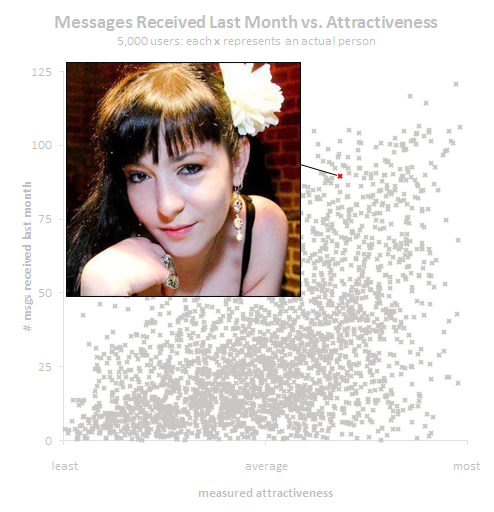
that gets more attention than her:
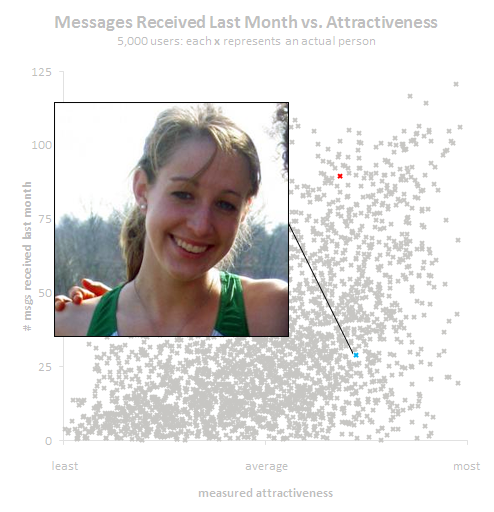
…even though according to our users, they’re both good-looking?"
(Rudder, 2011)
What the rest of the article begins to explore is the fact that the more that men disagree about a woman's looks, the more attention she gets overall. Here are bar graphs of each of the above women's ratings, along with information about how often they get messaged compared to the site average:

(Rudder, 2011)
Not only does the woman on the right, who rates slightly lower than the woman on the left on average, get more than double the site average amount of male attention, she gets almost three times as much attention as the woman on the left who is more consistently and universally considered attaractive.
After this initial experiment, Rudder thought that there must have been an error, and ran it over and over again, finding that regardless of the attractiveness of the pair of women chosen, as long as their male responses shared this discrepancy, this pattern held true. Here are two more examples:

(Rudder, 2011)
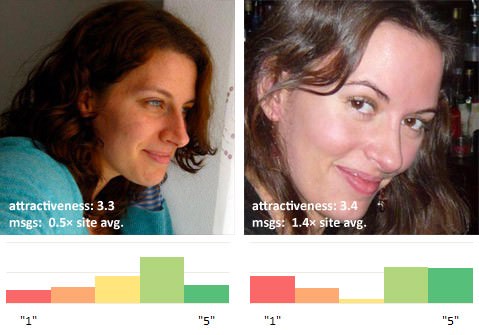
(Rudder, 2011)
Rudder postulates that what we call "Juggernaut Theory" is actually a derivative of Game Theory. Here is his explanation on the matter:
"Suppose you’re a man who’s really into someone. If you suspect other men are uninterested, it means less competition. You therefore have an added incentive to send a message. You might start thinking: maybe she’s lonely. . . maybe she’s just waiting to find a guy who appreciates her. . . at least I won’t get lost in the crowd. . . maybe these small thoughts, plus the fact that you really think she’s hot, prod you to action...
On the other hand, a woman with a preponderance of ‘4’ votes, someone conventionally cute, but not totally hot, might appear to be more in-demand than she actually is. To the typical man considering her, she’s obviously attractive enough to create the impression that other guys are into her, too. But maybe she’s not hot enough for him to throw caution (and grammar) to the wind and send her a message. It’s the curse of being cute."
(Rudder, 2011)
It is easy to see how game theory can be seen as a derivative of evolutionary psychology in this case. As was discussed earlier in this post, men who are seeking casual sex and relationships are actively seeking women who have a greater amount of sexual accessibility; in other words, women with whom they think they have the greatest chance of hooking up with. However, this strategy paradoxically leads to greater competition for the woman in question. This subject will be continued in the next section.
The conclusion that you may come to is that you will pursue the "quirky" girl who is only "low-key" hot but still tickles your fancy. You show your classmate/coworker/friend/cat her picture and he says "eh, she's not my type," which further fuels your belief that maybe, just maybe, you have a chance with her.
Unfortunately, this is the same conclusion that most men come to as well, and this is the basis of the "Juggernaut Theory," which loosely states that the "imperfections" a woman may have actually make her more attractive and desirable. I have seen this be justified by the presence of various fetish orientations, such as "chubby chasers" and "yellow fever." What I haven't seen mentioned on the topic until now is that this effect is in fact so strong that it makes women whose looks aren't considered to be conventionally attractive actually MORE attractive than women who receive the same attractiveness rating but are more consistently rated attractive.
That was a bit of word vomit, so I'll let the pictures and Christian Rudder explain it more clearly. After reviewing 1.54 million votes, 596 thousand messages, and 64 thousand profiles, here are the findings:
"Every so often we run diagnostic plots like the one below, showing how many messages a sampling of 5,000 women, sorted by attractiveness, received over the last month.

These graphs are adjusted for race, location, age, profile completeness, login activity, and so on — the only meaningful difference between the people plotted is their looks. After running a bunch of these, we began to ask ourselves: what else accounts for the wide spread of the x’s, particularly on the “above-average” half of the graph? Is it just randomness?
What is it about her:

that gets more attention than her:

…even though according to our users, they’re both good-looking?"
(Rudder, 2011)
What the rest of the article begins to explore is the fact that the more that men disagree about a woman's looks, the more attention she gets overall. Here are bar graphs of each of the above women's ratings, along with information about how often they get messaged compared to the site average:

(Rudder, 2011)
Not only does the woman on the right, who rates slightly lower than the woman on the left on average, get more than double the site average amount of male attention, she gets almost three times as much attention as the woman on the left who is more consistently and universally considered attaractive.
After this initial experiment, Rudder thought that there must have been an error, and ran it over and over again, finding that regardless of the attractiveness of the pair of women chosen, as long as their male responses shared this discrepancy, this pattern held true. Here are two more examples:

(Rudder, 2011)

(Rudder, 2011)
Rudder postulates that what we call "Juggernaut Theory" is actually a derivative of Game Theory. Here is his explanation on the matter:
"Suppose you’re a man who’s really into someone. If you suspect other men are uninterested, it means less competition. You therefore have an added incentive to send a message. You might start thinking: maybe she’s lonely. . . maybe she’s just waiting to find a guy who appreciates her. . . at least I won’t get lost in the crowd. . . maybe these small thoughts, plus the fact that you really think she’s hot, prod you to action...
On the other hand, a woman with a preponderance of ‘4’ votes, someone conventionally cute, but not totally hot, might appear to be more in-demand than she actually is. To the typical man considering her, she’s obviously attractive enough to create the impression that other guys are into her, too. But maybe she’s not hot enough for him to throw caution (and grammar) to the wind and send her a message. It’s the curse of being cute."
(Rudder, 2011)
It is easy to see how game theory can be seen as a derivative of evolutionary psychology in this case. As was discussed earlier in this post, men who are seeking casual sex and relationships are actively seeking women who have a greater amount of sexual accessibility; in other words, women with whom they think they have the greatest chance of hooking up with. However, this strategy paradoxically leads to greater competition for the woman in question. This subject will be continued in the next section.
What all of these potential pitfalls for men in the dating scene point to is that modern dating is very, very hard to succeed in as a man - unless you are NOT ugly, poor, ethnic, too old, too young, or finding yourself chasing Juggernauts.
What is it about modern dating that has made the strategies, that have been finely tuned by millions of years of evolution, actually backfire as they do in the case of the search for sexual accessibility being countered by Juggernaut theory?
To put it simply, this issue is multifaceted and complex, and I will only be able to address a couple of the contributing factors here. However, the beauty of evolutionary psychology is that one set of problem-solving techniques can explain a wide variety of questions. I will address some of those here:
Why have certain approaches seemingly changed with the times, while others have not?
Let us compare the evolutionary foundation of female selection to that of the Juggernaut theory.
Females have been selecting their mates based on certain values in both our species and others for millions of years. Some of those values seemingly produce detriments in the lives of males; a famous example is the peacock.
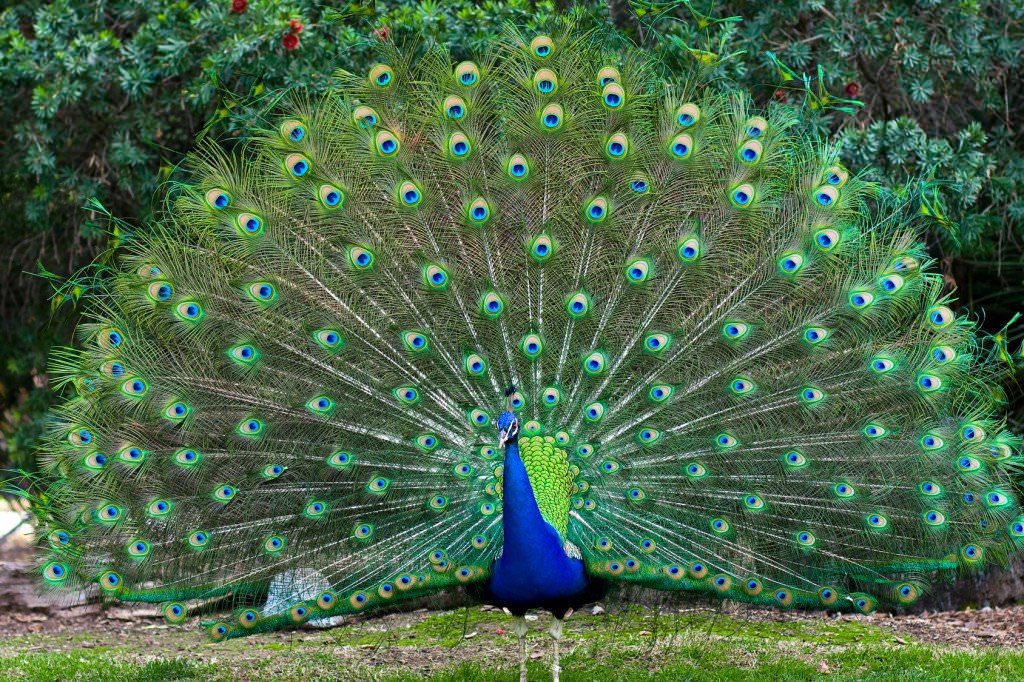
The male peacock boasts one of the most stunning visual displays aimed at attracting a mate. However, this massive tail does not come without a price. The brightly-colored peacock is so burdened by the tail that they struggle to fly over long distances or for a long duration, making them susceptible to predators. Beyond that, they are flamboyant, sporting a very rich color scheme that is also reflective in some parts. It is unsurprising that the same feathers that catch the female peacock's attention, also catch the attention of predators. So, how could such an evolutionary trait remain in the gene pool if the peacocks who are the most flamboyant are also the ones most susceptible to dying at the hands of a predator?
The answer lies in the fact that sexual selection is more powerful than even death, at least in the case of the peacock. If, for example, we have a population of peacocks in which 50 of the males are flamboyant, and 50 are neutral, then all 50 of the flamboyant ones would have to die before the 50 neutral ones are selected to reproduce. Once in a while, in times of desperation or extreme need, a female peacock may mate with a very dull male peacock, simply because she has no other options. However, because this is very rare, after a couple of generations within our sample populations of peacocks, the dull males' DNA will eventually be weeded out because they get selected for reproduction much less often than their flamboyant counterparts, even if the latter is also more likely to die.
So how does the peacock relate to our example of female selectivity for value? In humans, even though "value" as a definition has changed drastically since we left the trees in the jungle, waiting for a high value male has consistently yielded better results. Low value males' DNA has been systematically removed from our gene pool for millennia, and because this focus on high value males has led to consistent success, the selectivity of females continues on and on. While low value males are born and raised daily, this is due to a multitude of reasons, but ultimately none of them affect a females predisposition for selecting a higher value male. Similar to how "the rich get richer, the poor get poorer," if a female is born as a product of a woman's selecting a high value mate, the offspring is likely to be of higher value than the offspring born to a woman who did NOT select a higher value mate. That means that in the second generation, the female born to the selected man will likely be of higher genetic value and will maintain her selectivity; in essence, selectivity is akin to breeding, as the most genetically gifted continue to have the luxury of selecting a mate who is similarly gifted. Remember the "sexy sons" hypothesis?
A perfect example of this are the rumors about the Olympic Village being a veritable sex party. Tinder has proven that the rumors are true:
"During the Winter Olympics Tinder has seen a 348% increase in overall Tinder usage in the Olympic Village, plus a 565% in right swipes and a 644% increase in matches."
(Dating Sites Reviews, 2018)
When you put the most physically capable people, many of whom are at the pinnacle of genetic fitness, together in a small confined area, a sex bomb happens. It's like some sort of internal mechanism awakens in the men and women saying, "you may never get a chance to mate with a person quite as genetically fit as this; you can't waste the opportunity." The people who didn't make it to the Olympics as competitors are forced to watch from the sidelines and from the comfort of their living rooms, with no opportunity to share in the sexual pursuit of the greatest physical genetic potential on this planet.
In other words, to answer the first part of the question about why certain mating preferences have changed, the answer is that they only appear to have. Women on average don't seek the best hunter available to them in the West, they seek the most savvy businessman with the largest stock portfolio. However, in both cases, women were choosing based on "value," which is subjective to the surroundings and demands of the life a woman leads. By the way, this may explain why some cougars end up humoring those younger men. Numerous testimonials go along the lines of, "I already have money, a job, a house. What I don't have is hot steamy sex with a 20 year old man. I don't need him to provide for me, I just need his body." Once the woman has provided for herself, she no longer seeks a man to fit the provider's role, and instead changes her preferences to aim for a different "value" - attractiveness.
Moving on, why does Juggernaut theory seem to contradict the hypothesis that successful reproduction yields the continuation of genetically induced behaviors and preferences? After all, the woman who is less consistently deemed attractive is receiving a lot more male attention than her more consistently attractive counterpart, shouldn't this leave a lot of men in the dust and wanting, resulting in their proclivity for chasing Juggernauts to be filtered out of the gene pool?
While it is certainly true that if those men never reproduce at all, their Juggernaut-chasing genes die with them. However, this is not always the case. After chasing Juggernauts over and over, eventually he may run into one that is not quite as inconsistently rated attractive as his previous crushes, much more of a plain Jane. His DNA, and thus the manual for what to do when it's time for his offspring to engage in sexual escapades of their own, carry on.
Let's not forget about the lucky guy who managed to land Ms. Juggernaut. While the rest of the men may have missed their chance, this is an example of how Juggernaut theory led to success. As we learned before, sexual selection is a powerful driving force; he was selected, and so was his Juggernaut-chasing DNA, by a Juggernaut no less!
So, to answer the second part of the question, mating preferences and strategies that seem destined for failure continue on in our gene pool because they succeed enough times for them to carry on, and when they don't succeed, that doesn't mean that the man (or woman) who has them in their DNA never gets to reproduce at all.
What is it about the digital age that makes it more over for undesirable men than it ever was before?
While, again, there are multiple interrelated contributing factors at play, we can summarize some of them to being a part of one overarching issue: unprecedented competition.
As mentioned earlier in the post, we have stone age minds trapped in modern skulls. What this means is that, as demonstrated in answering the previous question, certain strategies and attributes have been fine tuned and have persisted for millions of years. In contrast, the digital age, and particularly online dating, are extremely recent developments in the sexual market. For comparison, if we think of the entirety of the 2 million years as being a process of strengthening and re-strengthening strategies such as female selectivity and think of it as being the equivalent of a single human lifetime (~80 years), then the advent of online dating would have come around 9 hours and 49 minutes before you died. In other words, online dating has been around for so little time, that it hasn't had a sizeable impact on our genetic foundation yet.
So, for all intents and purposes, we can say that the women who use dating services are at least predisposed in the same ways that women were predisposed to select mates ten thousand years ago (which is also only a small fraction of the 2 million years that these predispositions have been self-correcting through sexual selection). Ten thousand years ago, a woman would see maybe a couple hundred different male individuals in her life time at MOST, with the number likely to be much, much lower. Compare this to the fact that by going on Tinder in even a mid-range city will net you hundreds of profiles to choose from in a single day.
What does this mean? It simply means that women have many more options to choose from than they did before, so their selectivity naturally weeds out an even greater number of men. However, if in the past, her selectivity had a high chance of yielding only one or no results at all due to a dearth of options, even the pickiest women is likely to find a few matches EVERY DAY as long as her location and age restrictions aren't TOO selective. In the past, a woman would only be able to select from men that are from her clan, or in her little hunter/gatherer community. Nowadays, a woman can metaphorically see available men for miles around her with the swipe of a touch screen. If there are no cute guys in your town, you can just expand your search to include the surrounding 10 miles. Thus, women are far more likely to find what they are looking for without having to lower their standards.
This is augmented by the advent of:
1. Transportation technology. You found this cute guy and want to go fool around, but he is 15 miles away? You can be there in 30 minutes thanks to your car.
2. Communication technology. You want to talk to him to see if his interests line up with yours? You can text him right now instead of having to go see him or writing him snail mail.
3. Mass media. The media shows what attractive men look like every second of every day in commercials, movies, YouTube videos, ads, etc.
4. Urbanization. If you live in the city, there are more available men closer to you than ever before.
5. Globalization. You have a particular fetish/preference? The chances of someone satisfying that interest are much greater than they ever have been in the more homogeneous societies that existed not too long ago (and continue to exist in some areas, admittedly).
... and many many more.
Keep in mind that online dating is not only becoming more and more accepted in society, it is also becoming more prevalent in outcome relationships. According to the statistics, 1/3rd of modern marriages arise from relationships that started online on services like OkCupid, Tinder, Match.com, etc. They are far and away the leader in creating unions in same-sex couples, and are already firmly the second-most common point of origin for heterosexual couples (Ortega & Hergovich, 2017). In this rapidly evolving sexual market, it is the people who are worst equipped for online dating that are the ones who are left behind. It is imaginable that if this trend continues, we eventually will see shifts in human biology that reflect the dating and mating strategies and standards that are most successful in online dating.
How rampant is the selectivity nowadays?
Anyone with a search engine and enough interest can watch videos or view screenshots of how attractive women and even men experience dating services like Tinder. They log on, begin swiping, and receive hit after hit after hit. Messages upon messages. Compare this to the following statistics from 2014:
"50 million people use Tinder every month.
There are more than 1 billion profile swipes per day on Tinder.
Tinder makes 12 million matches made per day."
(Shontell, 2014)
That means that out of 1 billion swipes, only 1.2% result in a match. If we know that some individuals have the greatest chance of success, with videos showing a much higher percentage of successful swipes for them, where does that leave the rest of us? In other words, that 98.8% selectivity rate includes the most attractive members of society. Imagine what the success percentage rate is for men who are unattractive, ugly, ethnic, poor, too old, too young, or any combination of these undesirable qualities?
What is it about modern dating that has made the strategies, that have been finely tuned by millions of years of evolution, actually backfire as they do in the case of the search for sexual accessibility being countered by Juggernaut theory?
To put it simply, this issue is multifaceted and complex, and I will only be able to address a couple of the contributing factors here. However, the beauty of evolutionary psychology is that one set of problem-solving techniques can explain a wide variety of questions. I will address some of those here:
Why have certain approaches seemingly changed with the times, while others have not?
Let us compare the evolutionary foundation of female selection to that of the Juggernaut theory.
Females have been selecting their mates based on certain values in both our species and others for millions of years. Some of those values seemingly produce detriments in the lives of males; a famous example is the peacock.

The male peacock boasts one of the most stunning visual displays aimed at attracting a mate. However, this massive tail does not come without a price. The brightly-colored peacock is so burdened by the tail that they struggle to fly over long distances or for a long duration, making them susceptible to predators. Beyond that, they are flamboyant, sporting a very rich color scheme that is also reflective in some parts. It is unsurprising that the same feathers that catch the female peacock's attention, also catch the attention of predators. So, how could such an evolutionary trait remain in the gene pool if the peacocks who are the most flamboyant are also the ones most susceptible to dying at the hands of a predator?
The answer lies in the fact that sexual selection is more powerful than even death, at least in the case of the peacock. If, for example, we have a population of peacocks in which 50 of the males are flamboyant, and 50 are neutral, then all 50 of the flamboyant ones would have to die before the 50 neutral ones are selected to reproduce. Once in a while, in times of desperation or extreme need, a female peacock may mate with a very dull male peacock, simply because she has no other options. However, because this is very rare, after a couple of generations within our sample populations of peacocks, the dull males' DNA will eventually be weeded out because they get selected for reproduction much less often than their flamboyant counterparts, even if the latter is also more likely to die.
So how does the peacock relate to our example of female selectivity for value? In humans, even though "value" as a definition has changed drastically since we left the trees in the jungle, waiting for a high value male has consistently yielded better results. Low value males' DNA has been systematically removed from our gene pool for millennia, and because this focus on high value males has led to consistent success, the selectivity of females continues on and on. While low value males are born and raised daily, this is due to a multitude of reasons, but ultimately none of them affect a females predisposition for selecting a higher value male. Similar to how "the rich get richer, the poor get poorer," if a female is born as a product of a woman's selecting a high value mate, the offspring is likely to be of higher value than the offspring born to a woman who did NOT select a higher value mate. That means that in the second generation, the female born to the selected man will likely be of higher genetic value and will maintain her selectivity; in essence, selectivity is akin to breeding, as the most genetically gifted continue to have the luxury of selecting a mate who is similarly gifted. Remember the "sexy sons" hypothesis?
A perfect example of this are the rumors about the Olympic Village being a veritable sex party. Tinder has proven that the rumors are true:
"During the Winter Olympics Tinder has seen a 348% increase in overall Tinder usage in the Olympic Village, plus a 565% in right swipes and a 644% increase in matches."
(Dating Sites Reviews, 2018)
When you put the most physically capable people, many of whom are at the pinnacle of genetic fitness, together in a small confined area, a sex bomb happens. It's like some sort of internal mechanism awakens in the men and women saying, "you may never get a chance to mate with a person quite as genetically fit as this; you can't waste the opportunity." The people who didn't make it to the Olympics as competitors are forced to watch from the sidelines and from the comfort of their living rooms, with no opportunity to share in the sexual pursuit of the greatest physical genetic potential on this planet.
In other words, to answer the first part of the question about why certain mating preferences have changed, the answer is that they only appear to have. Women on average don't seek the best hunter available to them in the West, they seek the most savvy businessman with the largest stock portfolio. However, in both cases, women were choosing based on "value," which is subjective to the surroundings and demands of the life a woman leads. By the way, this may explain why some cougars end up humoring those younger men. Numerous testimonials go along the lines of, "I already have money, a job, a house. What I don't have is hot steamy sex with a 20 year old man. I don't need him to provide for me, I just need his body." Once the woman has provided for herself, she no longer seeks a man to fit the provider's role, and instead changes her preferences to aim for a different "value" - attractiveness.
Moving on, why does Juggernaut theory seem to contradict the hypothesis that successful reproduction yields the continuation of genetically induced behaviors and preferences? After all, the woman who is less consistently deemed attractive is receiving a lot more male attention than her more consistently attractive counterpart, shouldn't this leave a lot of men in the dust and wanting, resulting in their proclivity for chasing Juggernauts to be filtered out of the gene pool?
While it is certainly true that if those men never reproduce at all, their Juggernaut-chasing genes die with them. However, this is not always the case. After chasing Juggernauts over and over, eventually he may run into one that is not quite as inconsistently rated attractive as his previous crushes, much more of a plain Jane. His DNA, and thus the manual for what to do when it's time for his offspring to engage in sexual escapades of their own, carry on.
Let's not forget about the lucky guy who managed to land Ms. Juggernaut. While the rest of the men may have missed their chance, this is an example of how Juggernaut theory led to success. As we learned before, sexual selection is a powerful driving force; he was selected, and so was his Juggernaut-chasing DNA, by a Juggernaut no less!
So, to answer the second part of the question, mating preferences and strategies that seem destined for failure continue on in our gene pool because they succeed enough times for them to carry on, and when they don't succeed, that doesn't mean that the man (or woman) who has them in their DNA never gets to reproduce at all.
What is it about the digital age that makes it more over for undesirable men than it ever was before?
While, again, there are multiple interrelated contributing factors at play, we can summarize some of them to being a part of one overarching issue: unprecedented competition.
As mentioned earlier in the post, we have stone age minds trapped in modern skulls. What this means is that, as demonstrated in answering the previous question, certain strategies and attributes have been fine tuned and have persisted for millions of years. In contrast, the digital age, and particularly online dating, are extremely recent developments in the sexual market. For comparison, if we think of the entirety of the 2 million years as being a process of strengthening and re-strengthening strategies such as female selectivity and think of it as being the equivalent of a single human lifetime (~80 years), then the advent of online dating would have come around 9 hours and 49 minutes before you died. In other words, online dating has been around for so little time, that it hasn't had a sizeable impact on our genetic foundation yet.
So, for all intents and purposes, we can say that the women who use dating services are at least predisposed in the same ways that women were predisposed to select mates ten thousand years ago (which is also only a small fraction of the 2 million years that these predispositions have been self-correcting through sexual selection). Ten thousand years ago, a woman would see maybe a couple hundred different male individuals in her life time at MOST, with the number likely to be much, much lower. Compare this to the fact that by going on Tinder in even a mid-range city will net you hundreds of profiles to choose from in a single day.
What does this mean? It simply means that women have many more options to choose from than they did before, so their selectivity naturally weeds out an even greater number of men. However, if in the past, her selectivity had a high chance of yielding only one or no results at all due to a dearth of options, even the pickiest women is likely to find a few matches EVERY DAY as long as her location and age restrictions aren't TOO selective. In the past, a woman would only be able to select from men that are from her clan, or in her little hunter/gatherer community. Nowadays, a woman can metaphorically see available men for miles around her with the swipe of a touch screen. If there are no cute guys in your town, you can just expand your search to include the surrounding 10 miles. Thus, women are far more likely to find what they are looking for without having to lower their standards.
This is augmented by the advent of:
1. Transportation technology. You found this cute guy and want to go fool around, but he is 15 miles away? You can be there in 30 minutes thanks to your car.
2. Communication technology. You want to talk to him to see if his interests line up with yours? You can text him right now instead of having to go see him or writing him snail mail.
3. Mass media. The media shows what attractive men look like every second of every day in commercials, movies, YouTube videos, ads, etc.
4. Urbanization. If you live in the city, there are more available men closer to you than ever before.
5. Globalization. You have a particular fetish/preference? The chances of someone satisfying that interest are much greater than they ever have been in the more homogeneous societies that existed not too long ago (and continue to exist in some areas, admittedly).
... and many many more.
Keep in mind that online dating is not only becoming more and more accepted in society, it is also becoming more prevalent in outcome relationships. According to the statistics, 1/3rd of modern marriages arise from relationships that started online on services like OkCupid, Tinder, Match.com, etc. They are far and away the leader in creating unions in same-sex couples, and are already firmly the second-most common point of origin for heterosexual couples (Ortega & Hergovich, 2017). In this rapidly evolving sexual market, it is the people who are worst equipped for online dating that are the ones who are left behind. It is imaginable that if this trend continues, we eventually will see shifts in human biology that reflect the dating and mating strategies and standards that are most successful in online dating.
How rampant is the selectivity nowadays?
Anyone with a search engine and enough interest can watch videos or view screenshots of how attractive women and even men experience dating services like Tinder. They log on, begin swiping, and receive hit after hit after hit. Messages upon messages. Compare this to the following statistics from 2014:
"50 million people use Tinder every month.
There are more than 1 billion profile swipes per day on Tinder.
Tinder makes 12 million matches made per day."
(Shontell, 2014)
That means that out of 1 billion swipes, only 1.2% result in a match. If we know that some individuals have the greatest chance of success, with videos showing a much higher percentage of successful swipes for them, where does that leave the rest of us? In other words, that 98.8% selectivity rate includes the most attractive members of society. Imagine what the success percentage rate is for men who are unattractive, ugly, ethnic, poor, too old, too young, or any combination of these undesirable qualities?
Closing Thoughts
And Other Miscellaneous Information
What I hoped to demonstrate throughout the course of this post is that certain blackpills have strong empirical support for their veracity, both in scientific theory, study, and in the enormous data generated by dating websites and services. Even if we ignore all other factors potentially contributing to inceldom (especially shirking the factors that are merely associated with incels because of the actions of a few individuals), we still have a substantial foundation for asserting that dating in the digital age is incredibly difficult for those among us who are, as I've said numerous times, unattractive, ugly, ethnic, poor, too old, too young, or any combination of these undesirable qualities. This is what the blackpill is really about: the truth, supported by facts. When studies and data like this exist, it is impossible to swallow bluepilled ideologies such as "just put yourself out there" and "just be confident" when there are many inherent things about a man that can make him objectively undesirable in the sexual market.
After posting this thread, I will try to update both it and this post as I stumble upon more resources and information pertaining to the subject. For now, I have placed a quote in the "Miscellaneous Quotes + Information" section that I couldn't quite fit into my piece in its entirety, but I think is very interesting; this is where I will be placing the majority of consequent additions to the content.
Finally, I would like to thank the psychologists, researchers, corporate databases, journalists, authors, community members, and my colleagues whose work made this post a reality. I hope that future readers find it informative. Cheers.
After posting this thread, I will try to update both it and this post as I stumble upon more resources and information pertaining to the subject. For now, I have placed a quote in the "Miscellaneous Quotes + Information" section that I couldn't quite fit into my piece in its entirety, but I think is very interesting; this is where I will be placing the majority of consequent additions to the content.
Finally, I would like to thank the psychologists, researchers, corporate databases, journalists, authors, community members, and my colleagues whose work made this post a reality. I hope that future readers find it informative. Cheers.
"Men are programmed to conquer and monopolize women; women seek the best genetic input; 10% of children are not fathered by their fathers, less than 1% of the man’s sperm can fertilize an egg (the rest fight off other men’s sperm); vaginal mucus encourages some sperm but blocks others; women are more likely to get pregnant from a one-night stand than their regular partner."
(Baker, 2006)
"In suppressing intrasexual competition and reducing the size of the pool of unmarried men, normative monogamy reduces crime rates, including rape, murder, assault, robbery and fraud, as well as decreasing personal abuses."
(Henrich, Boyd, & Richerson, 2012, p. 657)
(Baker, 2006)
"In suppressing intrasexual competition and reducing the size of the pool of unmarried men, normative monogamy reduces crime rates, including rape, murder, assault, robbery and fraud, as well as decreasing personal abuses."
(Henrich, Boyd, & Richerson, 2012, p. 657)
References & Related Materials
For Further Reading
Baker, R. (2006). Sperm Wars: Infidelity, Sexual conflict, and Other Bedroom Battles. New York: Basic Books.
Bilton, N. (2014, October 29). Tinder, the Fast-Growing Dating App, Taps an Age-Old Truth. Retrieved from https://www.nytimes.com/2014/10/30/...h.html?module=Search&mabReward=relbias:s&_r=1
Buss, D. (2016). Evolution of Desire - Strategies of Human Mating. The Perseus Books Group.
Cooper, K. (2015, March 05). A Woman's advantage – The OkCupid Blog. Retrieved from https://theblog.okcupid.com/a-womans-advantage-82d5074dde2d
Cosmides, L., & Tooby, J. (1997). Evolutionary Psychology: A Primer. Santa Barbara: Center for Evolutionary Psychology, Santa Barbara.
Henrich, J., Boyd, R., & Richerson, P. J. (2012). The Puzzle of Monogamous Marriage. Philosophical Transactions of the Royal Society B: Biological Sciences, 367(1589), 657-669. doi:10.1098/rstb.2011.0290
Markowitz, D. (2017, June 01). Undressed: What's the Deal With the Age Gap in Relationships? Retrieved from https://theblog.okcupid.com/undressed-whats-the-deal-with-the-age-gap-in-relationships-3143a2ca5178
Murray, M. (2017, October 04). The 14 Dating Statistics All Singles Need to Know. Retrieved from https://www.zoosk.com/date-mix/dati...stics/14-dating-statistics-singles-need-know/
Nickalls, S. (2018, March 28). More Than Half of the People on Tinder Are Really, Really Bored. Retrieved from https://www.esquire.com/lifestyle/sex/a12149373/tinder-statistics-study/
OkCupid (2017, December 08). Feminism in Dating: It's not about making the first move, but having the choice. Retrieved from https://theblog.okcupid.com/feminis...first-move-but-having-the-choice-f4f2891dd4c9
Ortega, J., & Hergovich, P. (2017). The Strength of Absent Ties: Social Integration via Online Dating. SSRN Electronic Journal. doi:10.2139/ssrn.3044766
Reynolds, J. (2017, February 05). Women Today Are Rejecting Traditional Dating Standards More Than Ever. Retrieved from https://theblog.okcupid.com/women-t...-dating-standards-more-than-ever-7b890dab18be
Rudder, C. (2009, October 01). How Your Race Affects The Messages You Get – The OkCupid Blog. Retrieved from https://theblog.okcupid.com/how-your-race-affects-the-messages-you-get-39c68771b99e
Rudder, C. (2009, November 17). Your Looks and Your Inbox – The OkCupid Blog. Retrieved from https://theblog.okcupid.com/your-looks-and-your-inbox-8715c0f1561e
Rudder, C. (2010, February 16). The Case For An Older Woman – The OkCupid Blog. Retrieved from https://theblog.okcupid.com/the-case-for-an-older-woman-99d8cabacdf5
Rudder, C. (2010, July 07). The Big Lies People Tell In Online Dating – The OkCupid Blog. Retrieved from https://theblog.okcupid.com/the-big-lies-people-tell-in-online-dating-a9e3990d6ae2
Rudder, C. (2011, January 10). The Mathematics Of Beauty – The OkCupid Blog. Retrieved from https://theblog.okcupid.com/the-mathematics-of-beauty-51bd25ae9a75
Rudder, C. (2014, September 10). Race and Attraction, 2009–2014 – The OkCupid Blog. Retrieved from https://theblog.okcupid.com/race-and-attraction-2009-2014-107dcbb4f060
Rudder, C. (2014, September 28). Seven secrets of dating from the experts at OkCupid. Retrieved from https://www.theguardian.com/lifeand...secrets-of-dating-from-the-experts-at-okcupid
Shontell, A. (2014, October 30). NOPE: People Are Getting Rejected Hundreds Of Millions Of Times On Tinder Every Day. Retrieved from http://www.businessinsider.com/tinder-rejection-statistics-2014-10
Whitbourne, S. (2010, December 7). In-groups, out-groups, and the psychology of crowds. Retrieved from https://www.psychologytoday.com/us/...n-groups-out-groups-and-the-psychology-crowds
Workman, L., & Reader, W. (2014). Evolutionary Psychology: An Introduction. Cambridge, United Kingdom: Cambridge University Press.
Bilton, N. (2014, October 29). Tinder, the Fast-Growing Dating App, Taps an Age-Old Truth. Retrieved from https://www.nytimes.com/2014/10/30/...h.html?module=Search&mabReward=relbias:s&_r=1
Buss, D. (2016). Evolution of Desire - Strategies of Human Mating. The Perseus Books Group.
Cooper, K. (2015, March 05). A Woman's advantage – The OkCupid Blog. Retrieved from https://theblog.okcupid.com/a-womans-advantage-82d5074dde2d
Cosmides, L., & Tooby, J. (1997). Evolutionary Psychology: A Primer. Santa Barbara: Center for Evolutionary Psychology, Santa Barbara.
Henrich, J., Boyd, R., & Richerson, P. J. (2012). The Puzzle of Monogamous Marriage. Philosophical Transactions of the Royal Society B: Biological Sciences, 367(1589), 657-669. doi:10.1098/rstb.2011.0290
Markowitz, D. (2017, June 01). Undressed: What's the Deal With the Age Gap in Relationships? Retrieved from https://theblog.okcupid.com/undressed-whats-the-deal-with-the-age-gap-in-relationships-3143a2ca5178
Murray, M. (2017, October 04). The 14 Dating Statistics All Singles Need to Know. Retrieved from https://www.zoosk.com/date-mix/dati...stics/14-dating-statistics-singles-need-know/
Nickalls, S. (2018, March 28). More Than Half of the People on Tinder Are Really, Really Bored. Retrieved from https://www.esquire.com/lifestyle/sex/a12149373/tinder-statistics-study/
OkCupid (2017, December 08). Feminism in Dating: It's not about making the first move, but having the choice. Retrieved from https://theblog.okcupid.com/feminis...first-move-but-having-the-choice-f4f2891dd4c9
Ortega, J., & Hergovich, P. (2017). The Strength of Absent Ties: Social Integration via Online Dating. SSRN Electronic Journal. doi:10.2139/ssrn.3044766
Reynolds, J. (2017, February 05). Women Today Are Rejecting Traditional Dating Standards More Than Ever. Retrieved from https://theblog.okcupid.com/women-t...-dating-standards-more-than-ever-7b890dab18be
Rudder, C. (2009, October 01). How Your Race Affects The Messages You Get – The OkCupid Blog. Retrieved from https://theblog.okcupid.com/how-your-race-affects-the-messages-you-get-39c68771b99e
Rudder, C. (2009, November 17). Your Looks and Your Inbox – The OkCupid Blog. Retrieved from https://theblog.okcupid.com/your-looks-and-your-inbox-8715c0f1561e
Rudder, C. (2010, February 16). The Case For An Older Woman – The OkCupid Blog. Retrieved from https://theblog.okcupid.com/the-case-for-an-older-woman-99d8cabacdf5
Rudder, C. (2010, July 07). The Big Lies People Tell In Online Dating – The OkCupid Blog. Retrieved from https://theblog.okcupid.com/the-big-lies-people-tell-in-online-dating-a9e3990d6ae2
Rudder, C. (2011, January 10). The Mathematics Of Beauty – The OkCupid Blog. Retrieved from https://theblog.okcupid.com/the-mathematics-of-beauty-51bd25ae9a75
Rudder, C. (2014, September 10). Race and Attraction, 2009–2014 – The OkCupid Blog. Retrieved from https://theblog.okcupid.com/race-and-attraction-2009-2014-107dcbb4f060
Rudder, C. (2014, September 28). Seven secrets of dating from the experts at OkCupid. Retrieved from https://www.theguardian.com/lifeand...secrets-of-dating-from-the-experts-at-okcupid
Shontell, A. (2014, October 30). NOPE: People Are Getting Rejected Hundreds Of Millions Of Times On Tinder Every Day. Retrieved from http://www.businessinsider.com/tinder-rejection-statistics-2014-10
Whitbourne, S. (2010, December 7). In-groups, out-groups, and the psychology of crowds. Retrieved from https://www.psychologytoday.com/us/...n-groups-out-groups-and-the-psychology-crowds
Workman, L., & Reader, W. (2014). Evolutionary Psychology: An Introduction. Cambridge, United Kingdom: Cambridge University Press.









